Application of Laser Welding in Electric Vehicle Battery Manufacturing: A Review
Abstract
1. Introduction
2. Welding between Batteries and Busbars
2.1. Aluminum and Steel
2.2. Copper and Aluminum
2.3. Copper and Steel
3. Welding of Battery Housing
3.1. Welding of Aluminum Battery Housing
3.2. Welding of Steel Battery Housing
4. Summary and Outlook
Author Contributions
Funding
Institutional Review Board Statement
Informed Consent Statement
Data Availability Statement
Conflicts of Interest
References
- Li, Z.; Khajepour, A.; Song, J. A comprehensive review of the key technologies for pure electric vehicles. Energy 2019, 182, 824–839. [Google Scholar] [CrossRef]
- Eskander, S.M.S.U.; Fankhauser, S. Reduction in greenhouse gas emissions from national climate legislation. Nat. Clim. Chang. 2020, 10, 750–756. [Google Scholar] [CrossRef]
- Wimbadi, R.W.; Djalante, R. From decarbonization to low carbon development and transition: A systematic literature review of the conceptualization of moving toward net-zero carbon dioxide emission (1995–2019). J. Clean. Prod. 2020, 256, 120307. [Google Scholar] [CrossRef]
- Sun, X.; Li, Z.; Wang, X.; Li, C. Technology development of electric vehicles: A review. Energies 2019, 13, 90. [Google Scholar] [CrossRef]
- Faria, R.; Moura, P.; Delgado, J.; De Almeida, A.T. A sustainability assessment of electric vehicles as a personal mobility system. Energy Convers. Manag. 2012, 61, 19–30. [Google Scholar] [CrossRef]
- Whittingham, M.S. History, evolution, and future status of energy storage. In Proceedings of the IEEE; Institute of Electrical and Electronics Engineers Inc.: Manhattan, NY, USA, 2012; pp. 1518–1534. [Google Scholar] [CrossRef]
- Becker, J.; Nemeth, T.; Wegmann, R.; Sauer, D.U. Dimensioning and optimization of hybrid Li-ion battery systems for EVs. World Electr. Veh. J. 2018, 9, 19. [Google Scholar] [CrossRef]
- Das, A.; Li, D.; Williams, D.; Greenwood, D. Joining technologies for automotive battery systems manufacturing. World Electr. Veh. J. 2018, 9, 22. [Google Scholar] [CrossRef]
- Canis, W. Federal and State Incentives Heighten Consumer Interest in Electric Vehicles. Available online: www.carhistory4u.com (accessed on 19 June 2023).
- Zwicker, M.F.R.; Moghadam, M.; Zhang, W.; Nielsen, C.V. Automotive battery pack manufacturing—A review of battery to tab joining. J. Adv. Join. Process. 2020, 1, 100017. [Google Scholar] [CrossRef]
- Kumar, N.; Masters, I.; Das, A. In-depth evaluation of laser-welded similar and dissimilar material tab-to-busbar electrical interconnects for electric vehicle battery pack. J. Manuf. Process. 2021, 70, 78–96. [Google Scholar] [CrossRef]
- Brand, M.J.; Schmidt, P.A.; Zaeh, M.F.; Jossen, A. Welding techniques for battery cells and resulting electrical contact resistances. J. Energy Storage 2015, 1, 7–14. [Google Scholar] [CrossRef]
- Zhang, C.; Li, L. A coupled thermal-mechanical analysis of ultrasonic bonding mechanism. Metall. Mater. Trans. B Process Metall. Mater. Process. Sci. 2009, 40, 196–207. [Google Scholar] [CrossRef]
- Lee, S.; Kim, T.H.; Hu, S.J.; Cai, W.W.; Li, J.; Abell, J.A. Characterization of Joint Quality in Ultrasonic Welding of Battery Tabs MSEC2012-7410. Available online: http://proceedings.asmedigitalcollection.asme.org/pdfaccess.ashx?url=/data/conferences/asmep/75447/ (accessed on 19 June 2023).
- Institutul de Cercetări Pentru Industria Electrotehnică, Association for Promoting Electric Vehicles in Romania, IEEE Circuits and Systems Society, Institute of Electrical and Electronics Engineers, IEEE Power & Energy Society, and Romania. Ministerul Educației și Cercetării Științifice. In Proceedings of the 2019 Electric Vehicles International Conference (EV): Icpe Solar Park, Bucharest, Romania, 3–4 October 2019. [Google Scholar]
- Luan, B.L.; Campbell, G.; Gauthier, M.; Liu, X.Y.; Davidson, I.; Nagata, J.; Lépinay, M.; Bernier, F.; Argue, S. Surface Modification and Fabrication of Li-Ion Battery Components for Plug-In Hybrid Electric Vehicle. ECS Trans. 2010, 25, 59–71. [Google Scholar] [CrossRef]
- Schweier, M.; Heins, J.F.; Haubold, M.W.; Zaeh, M.F. Spatter formation in laser welding with beam oscillation. Phys. Procedia 2013, 41, 20–30. [Google Scholar] [CrossRef]
- Bonenberger, P.R. The First Snap-Fit Handbook: Creating and Managing Attachments for Plastics Parts; Carl Hanser Verlag GmbH Co. KG: Munich, Germany, 2016. [Google Scholar]
- Niu, P.; Li, R.; Fan, Z.; Cao, P.; Zheng, D.; Wang, M.; Deng, C.; Yuan, T. Inhibiting cracking and improving strength for additive manufactured AlxCoCrFeNi high entropy alloy via changing crystal structure from BCC-to-FCC. Addit. Manuf. 2023, 71, 103584. [Google Scholar] [CrossRef]
- Springer, H.; Kostka, A.; Santos, J.F.D.; Raabe, D. Influence of intermetallic phases and Kirkendall-porosity on the mechanical properties of joints between steel and aluminium alloys. Mater. Sci. Eng. A 2011, 528, 4630–4642. [Google Scholar] [CrossRef]
- Kouadri-David, A. Study of metallurgic and mechanical properties of laser welded heterogeneous joints between DP600 galvanised steel and aluminium 6082. Mater. Des. 2014, 54, 184–195. [Google Scholar] [CrossRef]
- Ghosh, M.; Chatterjee, S.; Mishra, B. The effect of intermetallics on the strength properties of diffusion bonds formed between Ti-5.5Al-2.4V and 304 stainless steel. Mater. Sci. Eng. A 2003, 363, 268–274. [Google Scholar] [CrossRef]
- Bozzi, S.; Helbert-Etter, A.L.; Baudin, T.; Criqui, B.; Kerbiguet, J.G. Intermetallic compounds in Al 6016/IF-steel friction stir spot welds. Mater. Sci. Eng. A 2010, 527, 4505–4509. [Google Scholar] [CrossRef]
- Qiu, R.; Iwamoto, C.; Satonaka, S. The influence of reaction layer on the strength of aluminum/steel joint welded by resistance spot welding. Mater. Charact. 2009, 60, 156–159. [Google Scholar] [CrossRef]
- Zhou, D.W.; Liu, J.S.; Lu, Y.Z.; Xu, S.H. Effect of adding powder on joint properties of laser penetration welding for dual phase steel and aluminum alloy. Opt. Laser Technol. 2017, 94, 171–179. [Google Scholar] [CrossRef]
- Shahverdi, H.R.; Ghomashchi, M.R.; Shabestari, S.; Hejazi, J. Microstructural analysis of interfacial reaction between molten aluminium and solid iron. J. Mater. Process. Technol. 2002, 124, 345–352. [Google Scholar] [CrossRef]
- Cinca, N.; Lima, C.R.C.; Guilemany, J.M. An overview of intermetallics research and application: Status of thermal spray coatings. J. Mater. Res. Technol. 2013, 2, 75–86. [Google Scholar] [CrossRef]
- Indhu, R.; Soundarapandian, S.; Vijayaraghavan, L. Yb: YAG laser welding of dual phase steel to aluminium alloy. J. Mater. Process. Technol. 2018, 262, 411–421. [Google Scholar] [CrossRef]
- Yang, J.; Li, Y.L.; Zhang, H. Microstructure and mechanical properties of pulsed laser welded Al/steel dissimilar joint. Trans. Nonferrous Met. Soc. China 2016, 26, 994–1002. [Google Scholar] [CrossRef]
- Chen, R.; Wang, C.; Jiang, P.; Shao, X.; Zhao, Z.; Gao, Z.; Yue, C. Effect of axial magnetic field in the laser beam welding of stainless steel to aluminum alloy. Mater. Des. 2016, 109, 146–152. [Google Scholar] [CrossRef]
- Torkamany, M.J.; Tahamtan, S.; Sabbaghzadeh, J. Dissimilar welding of carbon steel to 5754 aluminum alloy by Nd:YAG pulsed laser. Mater. Des. 2010, 31, 458–465. [Google Scholar] [CrossRef]
- Chen, S.; Huang, J.; Ma, K.; Zhang, H.; Zhao, X. Influence of a Ni-foil interlayer on Fe/Al dissimilar joint by laser penetration welding. Mater. Lett. 2012, 79, 296–299. [Google Scholar] [CrossRef]
- Cao, X.; Zhou, X.; Wang, H.; Luo, Z.; Duan, J. Microstructures and mechanical properties of laser offset welded 5052 aluminum to press-hardened steel. J. Mater. Res. Technol. 2020, 9, 5378–5390. [Google Scholar] [CrossRef]
- Wei, P.; Chen, Z.; Wang, D.; Zhang, R.; Li, X.; Zhang, F.; Sun, K.; Lei, Y. Effect of laser cleaning on mechanical properties of laser lap welded joint of SUS310S stainless steel and 6061 aluminum alloy. Mater. Lett. 2021, 291, 129549. [Google Scholar] [CrossRef]
- Asirvatham, M.C.; Collins, S.; Masters, I. Laser wobble welding of steel to Aluminium busbar joints for Li-ion battery packs. Opt. Laser Technol. 2022, 151, 108000. [Google Scholar] [CrossRef]
- Sierra, G.; Peyre, P.; Beaume, F.D.; Stuart, D.; Fras, G. Steel to aluminium braze welding by laser process with Al-12Si filler wire. Sci. Technol. Weld. Join. 2008, 13, 430–437. [Google Scholar] [CrossRef]
- Zhang, M.J.; Chen, G.Y.; Zhang, Y.; Wu, K.R. Research on microstructure and mechanical properties of laser keyhole welding-brazing of automotive galvanized steel to aluminum alloy. Mater. Des. 2013, 45, 24–30. [Google Scholar] [CrossRef]
- Xia, H.; Zhao, X.; Tan, C.; Chen, B.; Song, X.; Li, L. Effect of Si content on the interfacial reactions in laser welded-brazed Al/steel dissimilar butted joint. J. Mater. Process. Technol. 2018, 258, 9–21. [Google Scholar] [CrossRef]
- Xia, C.Z.; Li, Y.J.; Wang, J.; Ma, H.J. Microstructure and phase constitution near interface of Cu/Al vacuum brazing. Mater. Sci. Technol. 2007, 23, 815–818. [Google Scholar] [CrossRef]
- Lee, S.J.; Nakamura, H.; Kawahito, Y.; Katayama, S. Effect of welding speed on microstructural and mechanical properties of laser lap weld joints in dissimilar Al and Cu sheets. Sci. Technol. Weld. Join. 2014, 19, 111–118. [Google Scholar] [CrossRef]
- Stritt, P.; Hagenlocher, C.; Kizler, C.; Weber, R.; Rüttimann, C.; Graf, T. Laser spot welding of copper-aluminum joints using a pulsed dual wavelength laser at 532 and 1064 nm. Phys. Procedia 2014, 56, 759–767. [Google Scholar] [CrossRef]
- Mys, I.; Schmidt, M. Laser micro welding of copper and aluminum. In Laser-Based Micropackaging; SPIE: Bellingham WA, USA, 2006; p. 610703. [Google Scholar] [CrossRef]
- Messler, R.W. Joining of Materials and Structures; Chapter 15—Joining Dissimilar Material Combinations; Elsevier: Amsterdam, The Netherlands, 2004; pp. 697–741. [Google Scholar] [CrossRef]
- Li, Y.; Zou, W.; Lee, B.; Babkin, A.; Chang, Y. Research progress of aluminum alloy welding technology. Int. J. Adv. Manuf. Technol. 2020, 109, 1207–1218. [Google Scholar] [CrossRef]
- Heideman, R.; Johnson, C.; Kou, S. Metallurgical analysis of Al/Cu friction stir spot welding. Sci. Technol. Weld. Join. 2010, 15, 597–604. [Google Scholar] [CrossRef]
- Guo, Y.; Qiao, G.; Jian, W.; Zhi, X. Microstructure and tensile behavior of Cu-Al multi-layered composites prepared by plasma activated sintering. Mater. Sci. Eng. A 2010, 527, 5234–5240. [Google Scholar] [CrossRef]
- Abbasi, M.; Taheri, A.K.; Salehi, M.T. Growth Rate of Intermetallic Compounds in Al/Cu Bimetal Produced by Cold Roll Welding Process. 2001. Available online: www.elsevier.com/locate/jallcom (accessed on 19 June 2023).
- Mai, T.A.; Spowage, A.C. Characterisation of dissimilar joints in laser welding of steel-kovar, copper-steel and copper-aluminium. Mater. Sci. Eng. A 2004, 374, 224–233. [Google Scholar] [CrossRef]
- Ali, S.; Shin, J. In-Depth Characterization of Laser-Welded Aluminum-and-Copper Dissimilar Joint for Electric Vehicle Battery Connections. Materials 2022, 15, 7463. [Google Scholar] [CrossRef]
- Lee, S.J.; Choi, K.D.; Lee, S.J.; Shin, D.S.; Jung, J.P. Welding Properties of Dissimilar Al-Cu Thin Plate by a Single-Mode Fiber Laser. Metals 2022, 12, 1957. [Google Scholar] [CrossRef]
- Hailat, M.M.; Mian, A.; Chaudhury, Z.A.; Newaz, G.; Patwa, R.; Herfurth, H.J. Laser micro-welding of aluminum and copper with and without tin foil alloy. Microsyst. Technol. 2012, 18, 103–112. [Google Scholar] [CrossRef]
- Xue, Z.; Hu, S.; Shen, J.; Zuo, D.; Kannatey-Asibu, E. Microstructure characterization and mechanical properties of laser-welded copper and aluminum lap joint. J. Laser Appl. 2014, 26, 012002. [Google Scholar] [CrossRef]
- Weigl, M.; Albert, F.; Schmidt, M. Enhancing the ductility of laser-welde copper-aluminum connections by using adapted filler materia. Phys. Procedia 2011, 12, 332–338. [Google Scholar] [CrossRef]
- Sun, Z.; Ion, J.C. Review Laser welding of dissimilar metal combinations. J. Mater. Sci. 1995, 30, 4205–4214. [Google Scholar] [CrossRef]
- Shi, R.P.; Wang, C.P.; Wheeler, D.; Liu, X.J.; Wang, Y. Formation mechanisms of self-organized core/shell and core/shell/corona microstructures in liquid droplets of immiscible alloys. Acta Mater. 2013, 61, 1229–1243. [Google Scholar] [CrossRef]
- Phanikumar, G.; Manjini, S.; Dutta, P.; Mazumder, J.; Chattopadhyay, K. Characterization of a Continuous CO2 Laser-Welded Fe-Cu Dissimilar Couple. Met. Mater. Trans. A 2005, 36, 2137–2147. [Google Scholar] [CrossRef]
- Velu, M.; Bhat, S. Metallurgical and mechanical examinations of steel-copper joints arc welded using bronze and nickel-base superalloy filler materials. Mater. Des. 2013, 47, 793–809. [Google Scholar] [CrossRef]
- Joshi, G.R.; Badheka, V.J. Processing of bimetallic steel-copper joint by laser beam welding. Mater. Manuf. Process. 2019, 34, 1232–1242. [Google Scholar] [CrossRef]
- Meng, Y.; Li, X.; Gao, M.; Zeng, X. Microstructures and mechanical properties of laser-arc hybrid welded dissimilar pure copper to stainless steel. Opt. Laser Technol. 2019, 111, 140–145. [Google Scholar] [CrossRef]
- Chen, S.; Huang, J.; Xia, J.; Zhang, H.; Zhao, X. Microstructural characteristics of a stainless steel/copper dissimilar joint made by laser welding. Met. Mater. Trans. A 2013, 44, 3690–3696. [Google Scholar] [CrossRef]
- Yan, F.; Qin, Y.; Tang, B.; Zhou, Y.; Gao, Z.; Hu, Y.; Hu, C.; Xiao, Z.; Xiao, Z.; Wang, C. Effects of beam oscillation on microstructural characteristics and mechanical properties in laser welded steel-copper joints. Opt. Laser Technol. 2022, 148, 107739. [Google Scholar] [CrossRef]
- Mannucci, A.; Tomashchuk, I.; Vignal, V.; Sallamand, P.; Duband, M. Parametric study of laser welding of copper to austenitic stainless steel. Procedia CIRP 2018, 74, 450–455. [Google Scholar] [CrossRef]
- Li, J.; Cai, Y.; Yan, F.; Wang, C.; Zhu, Z.; Hu, C. Porosity and liquation cracking of dissimilar Nd:YAG laser welding of SUS304 stainless steel to T2 copper. Opt. Laser Technol. 2020, 122, 105881. [Google Scholar] [CrossRef]
- Shen, H.; Gupta, M.C. Nd:yttritium–aluminum–garnet laser welding of copper to stainless steel. J. Laser Appl. 2004, 16, 2–8. [Google Scholar] [CrossRef]
- Kirchhoff, M. Laser applications in battery production—From cutting foils to welding the case. In Proceedings of the 2013 3rd International Electric Drives Production Conference (EDPC), Nuremberg, Germany, 29–30 October 2013. [Google Scholar] [CrossRef]
- Kawahito, Y.; Matsumoto, N.; Abe, Y.; Katayama, S. Relationship of laser absorption to keyhole behavior in high power fiber laser welding of stainless steel and aluminum alloy. J. Mater. Process. Technol. 2011, 211, 1563–1568. [Google Scholar] [CrossRef]
- Katayama, S.; Nagayama, H.; Mizutani, M.; Kawahito, Y. Fibre laser welding of aluminium alloy. Weld. Int. 2009, 23, 744–752. [Google Scholar] [CrossRef]
- Xiao, R. Laser beam welding of aluminum alloys. In Lasers in Material Processing and Manufacturing III; SPIE: Bellingham, WA, USA, 2007; p. 682505. [Google Scholar] [CrossRef]
- Xiao, R.; Zhang, X. Problems and issues in laser beam welding of aluminum-lithium alloys. J. Manuf. Process. 2014, 16, 166–175. [Google Scholar] [CrossRef]
- Wu, Q.; Xiao, R.S.; Zou, J.L.; Xu, J.J. Weld formation mechanism during fiber laser welding of aluminum alloys with focus rotation and vertical oscillation. J. Manuf. Process. 2018, 36, 149–154. [Google Scholar] [CrossRef]
- Möller, M.; Vogt, S. Novel multi focus optic approach for gas-tight welding of aluminum alloys in e-mobility. Procedia CIRP 2022, 111, 774–777. [Google Scholar] [CrossRef]
- Prieto, C.; Vaamonde, E.; Diego-Vallejo, D.; Jimenez, J.; Urbach, B.; Vidne, Y.; Shekel, E. Dynamic laser beam shaping for laser aluminium welding in e-mobility applications. Procedia CIRP 2020, 94, 596–600. [Google Scholar] [CrossRef]
- Abeyrathna, B.; Zhang, P.; Pereira, M.P.; Wilkosz, D.; Weiss, M. Micro-roll forming of stainless steel bipolar plates for fuel cells. Int. J. Hydrogen Energy 2019, 44, 3861–3875. [Google Scholar] [CrossRef]
- Salgado, M.D.F.; Rodrigues, S.C.; Santos, D.M.; Brandim, A.S.; Lins, V.F. Cyclic oxidation resistance of ferritic stainless steels used in mufflers of automobiles. Eng. Fail. Anal. 2017, 79, 89–97. [Google Scholar] [CrossRef]
- Samaniego-Gámez, O.; Almeraya-Calderón, F.; Chacón-Nava, J.; Maldonado-Bandala, E.; Nieves-Mendoza, D.; Rios, J.P.F.-D.L.; Jáquez-Muñoz, J.M.; Delgado, A.D.; Gaona-Tiburcio, C. Corrosion Behavior of Passivated CUSTOM450 and AM350 Stainless Steels for Aeronautical Applications. Metals 2022, 12, 666. [Google Scholar] [CrossRef]
- Schröder, C.; Wendler, M.; Kreschel, T.; Volkova, O.; Weiß, A. Development of a stainless austenitic nitrogen-alloyed crmnnimo spring steel. Crystals 2019, 9, 456. [Google Scholar] [CrossRef]
- De Baglion, L.; Mendez, J. Low cycle fatigue behavior of a type 304L austenitic stainless steel in air or in vacuum, at 20 °C or at 300 °C: Relative effect of strain rate and environment. Procedia Eng. 2010, 2, 2171–2179. [Google Scholar] [CrossRef]
- Zhang, H.W.; Xu, Y.L.; Chen, L.J.; Wang, X.W.; Wu, Z.Y.; Li, S.; Li, J.; Xiao, X.S. Precipitation Behaviors of a New Antibacterial Maraging Stainless Steel for Medical Instruments. Met. Mater. Trans. A 2018, 49, 3753–3761. [Google Scholar] [CrossRef]
- Alcock, J.A.; Baufeld, B. Diode laser welding of stainless steel 304L. J. Mater. Process. Technol. 2017, 240, 138–144. [Google Scholar] [CrossRef]
- Shankar, V.; Gill, T.P.S.; Mannan, S.L.; Sundaresan, S. Solidification cracking in austenitic stainless steel welds. Sadhana 2003, 28, 359–382. [Google Scholar] [CrossRef]
- Reitz, W. A Review of: ‘Welding Metallurgy and Weldability of Stainless Steel’. Mater. Manuf. Process. 2006, 21, 219. [Google Scholar] [CrossRef]
- Nishimoto, K.; Saida, K.; Kiuchi, K.; Nakayama, J. Influence of minor and impurity elements on hot cracking susceptibility of extra high-purity type 310 stainless steels. In Hot Cracking Phenomena in Welds III; Springer: Berlin/Heidelberg, Germany, 2011; pp. 183–208. [Google Scholar] [CrossRef]
- Almomani, A.; Mourad, A.H.I.; Barsoum, I. Effect of sulfur, phosphorus, silicon, and delta ferrite on weld solidification cracking of AISI 310S austenitic stainless steel. Eng. Fail. Anal. 2022, 139, 106488. [Google Scholar] [CrossRef]
- Lienert, T.J.; Lippold, J.C. Improved weldability diagram for pulsed laser welded austenitic stainless steels. Sci. Technol. Weld. Join. 2003, 8, 1–9. [Google Scholar] [CrossRef]
- Ning, J.; Wen, J.H.; Zhang, L.J.; Na, S.J. Assessment of the universality of duplex stainless steel powder in laser additive repair based on Schaeffler diagram. Addit. Manuf. 2022, 55, 102864. [Google Scholar] [CrossRef]
- Varol, I.; Baeslack, W.A., III; Lippold, J.C. Characterization of Weld Solidification Cracking in a Duplex Stainless Steel. Metallography 1989, 23, 1–19. [Google Scholar] [CrossRef]
- Yan, J.; Gao, M.; Zeng, X. Study on microstructure and mechanical properties of 304 stainless steel joints by TIG, laser and laser-TIG hybrid welding. Opt. Lasers Eng. 2010, 48, 512–517. [Google Scholar] [CrossRef]
- P’ng, D.; Molian, P. Q-switch Nd:YAG laser welding of AISI 304 stainless steel foils. Mater. Sci. Eng. A 2008, 486, 680–685. [Google Scholar] [CrossRef]
- Zhang, M.; Chen, G.; Zhou, Y.; Liao, S. Optimization of deep penetration laser welding of thick stainless steel with a 10 kW fiber laser. Mater. Des. 2014, 53, 568–576. [Google Scholar] [CrossRef]
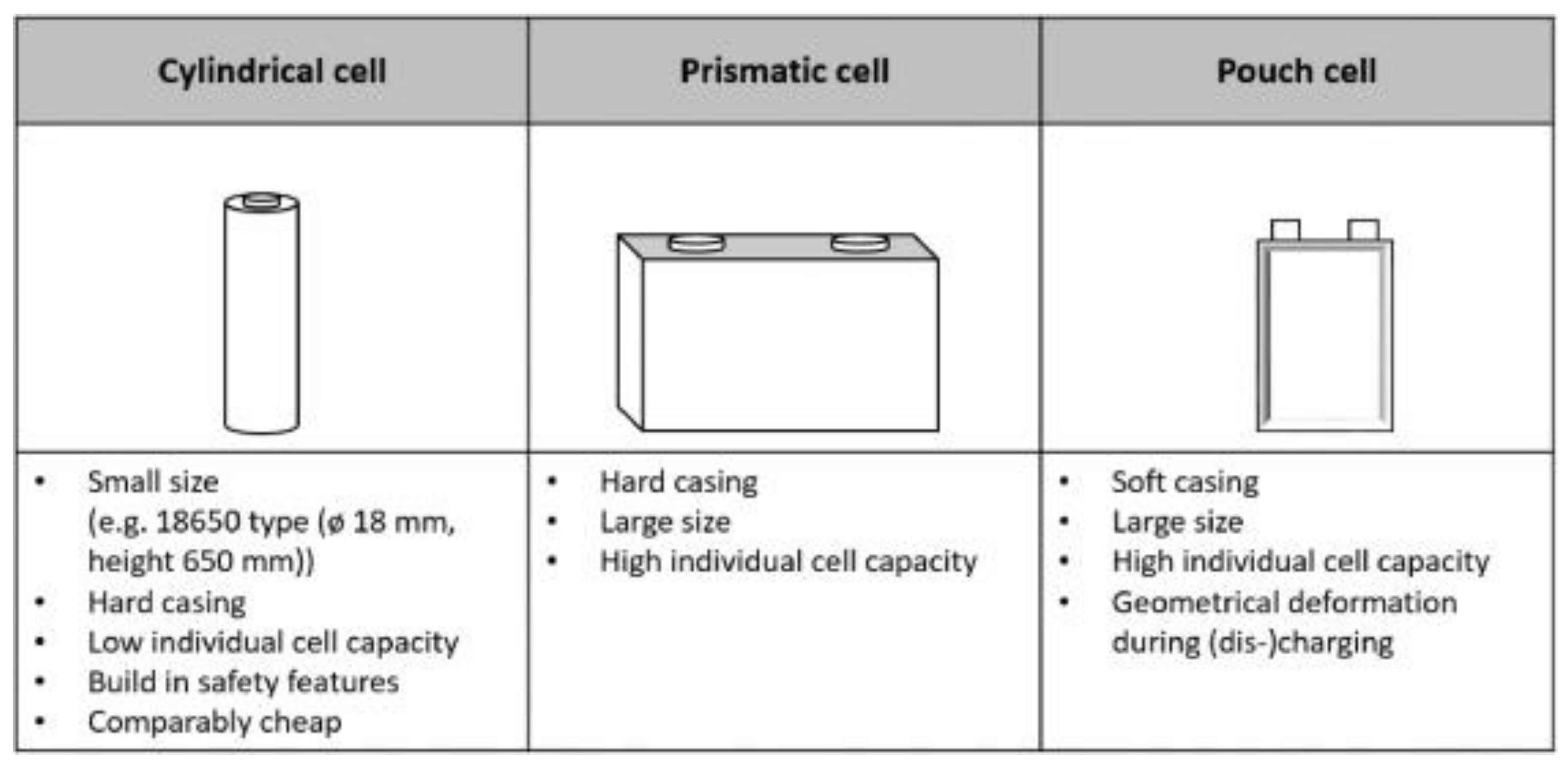
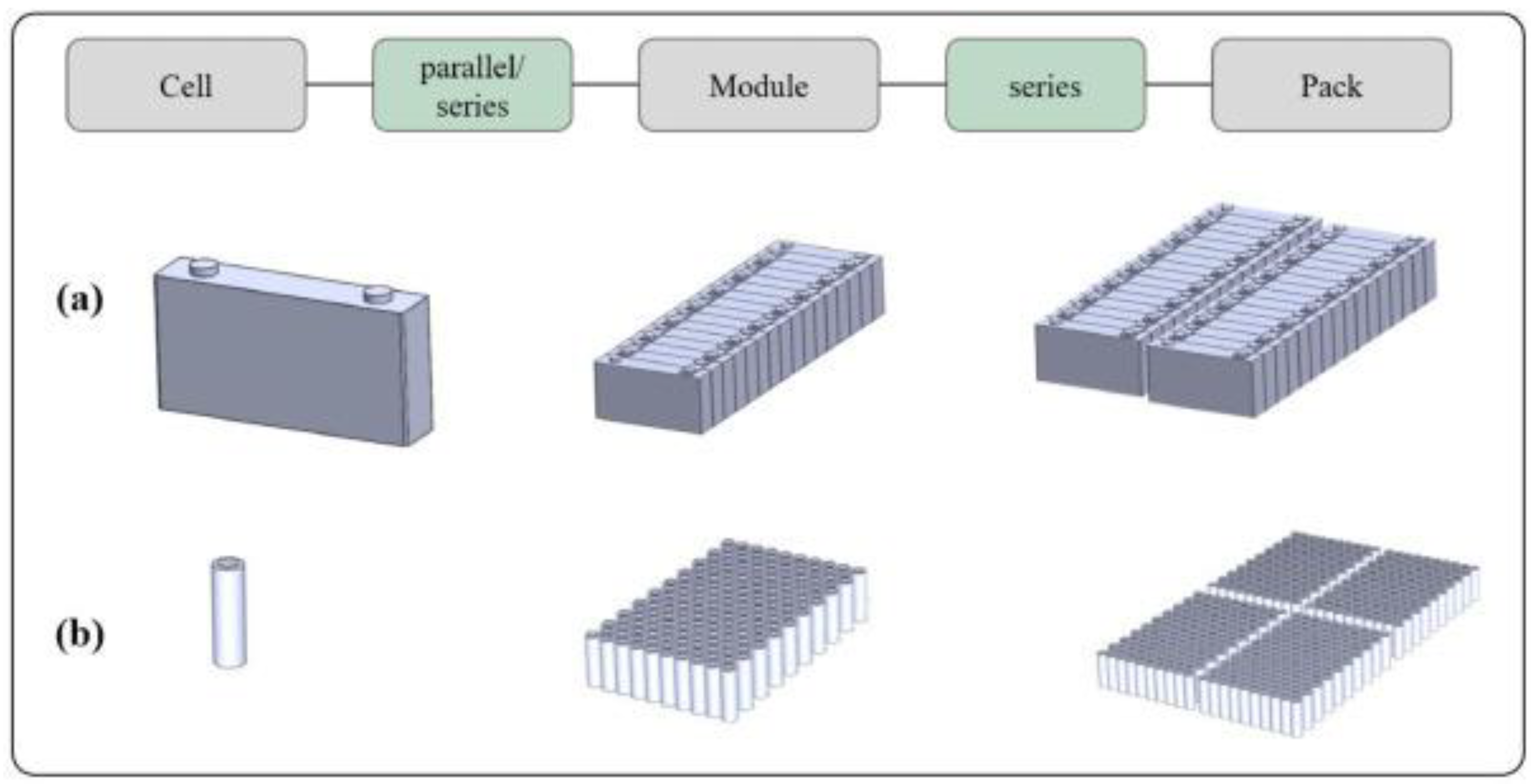

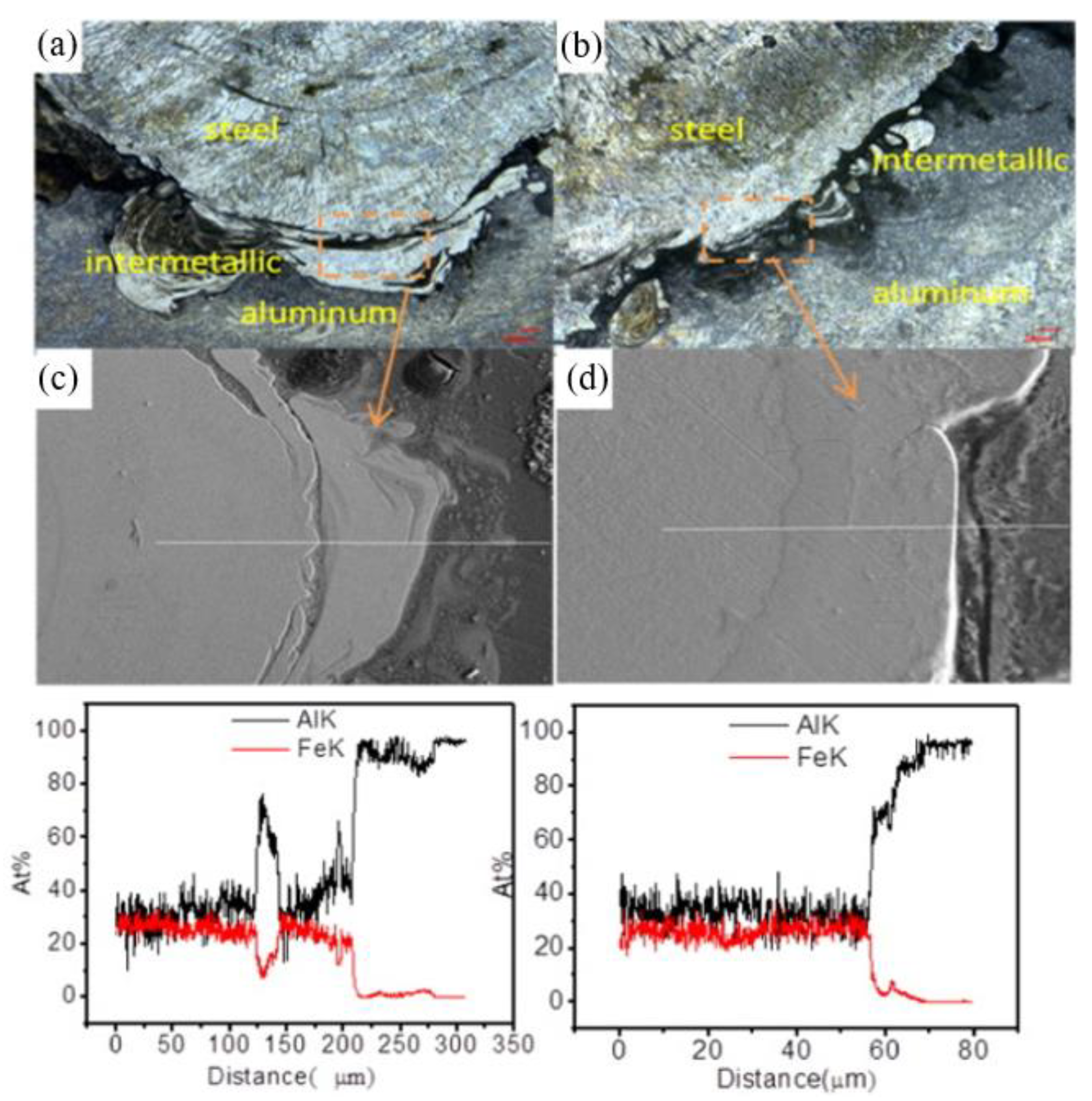
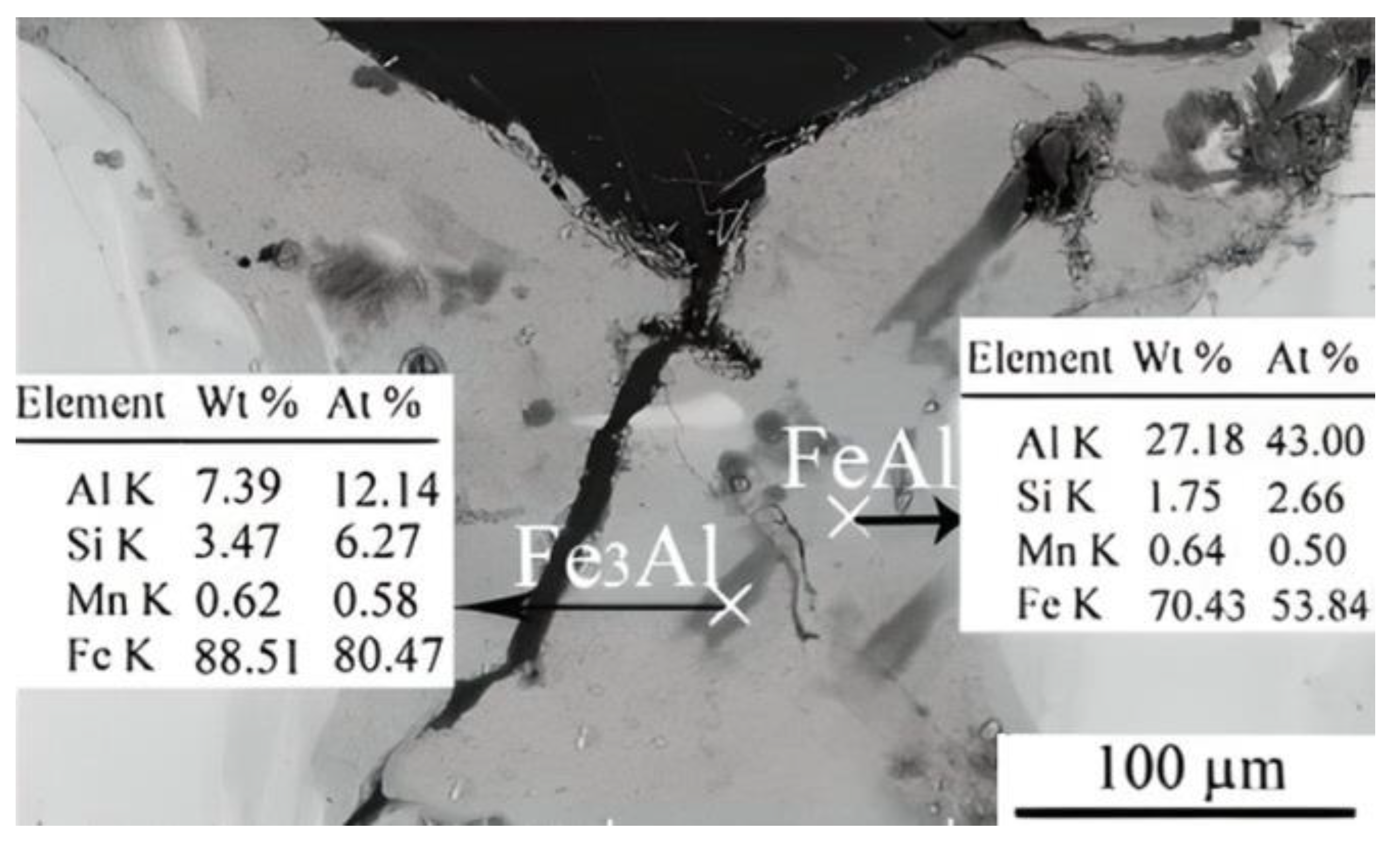
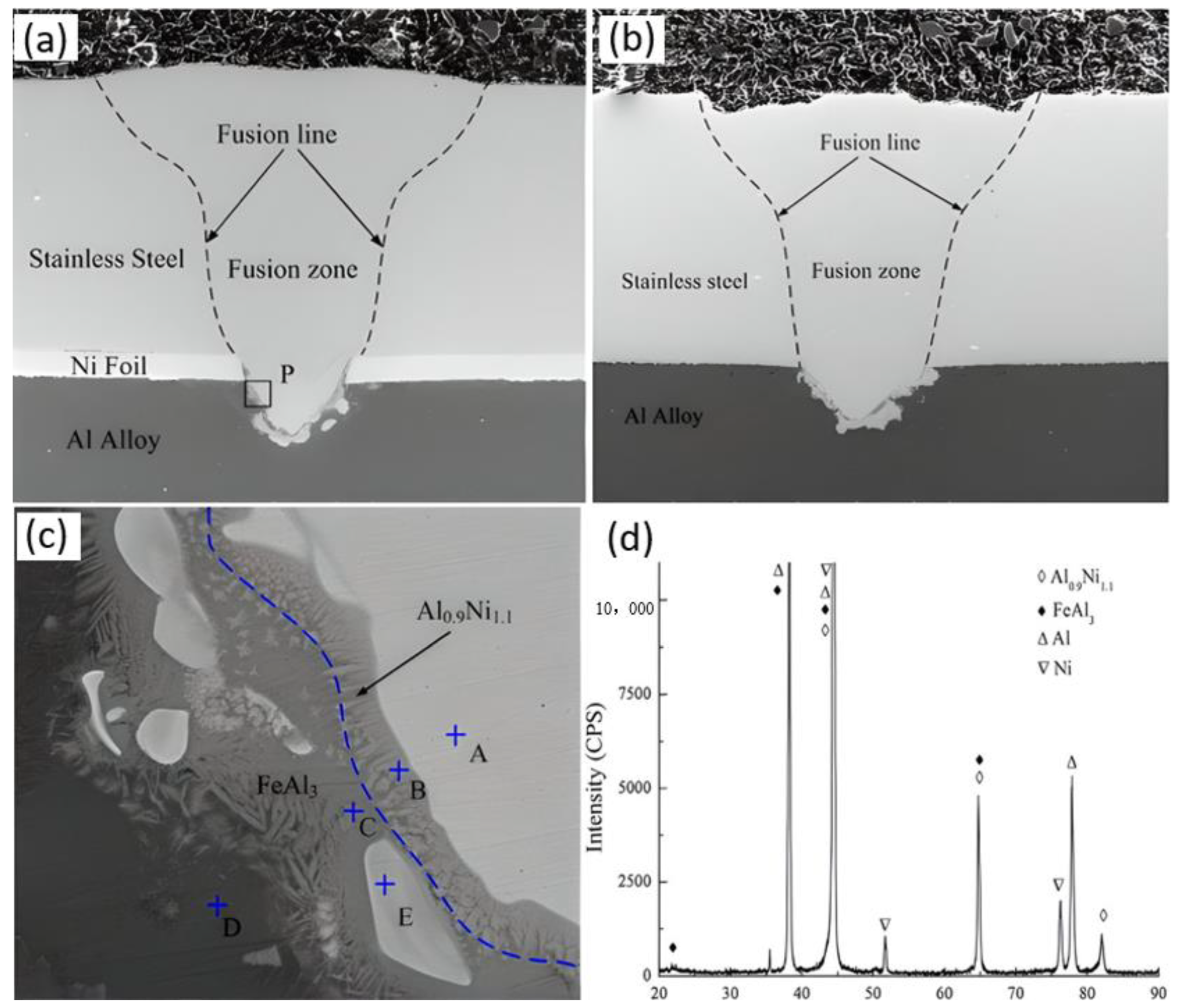
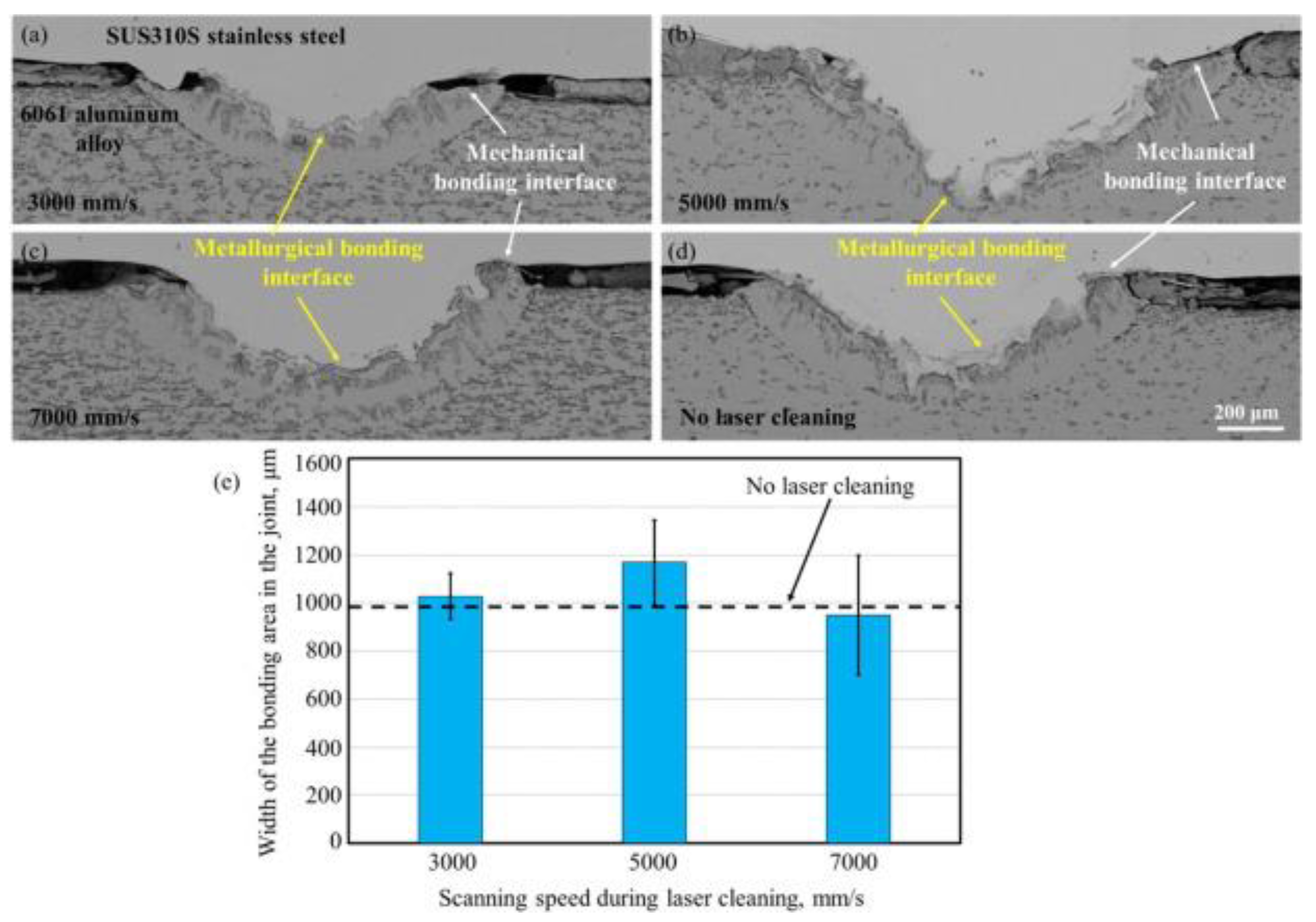
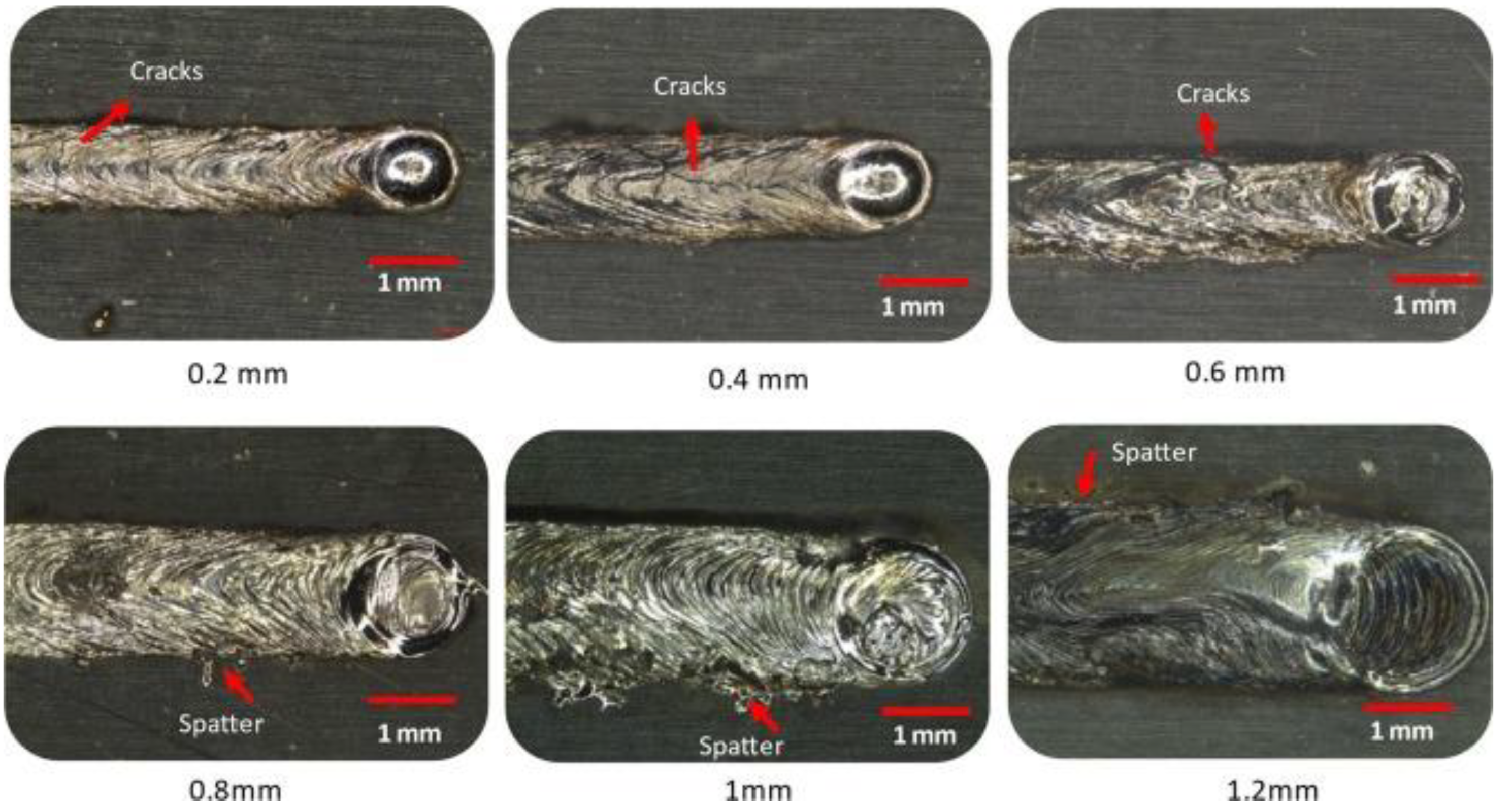
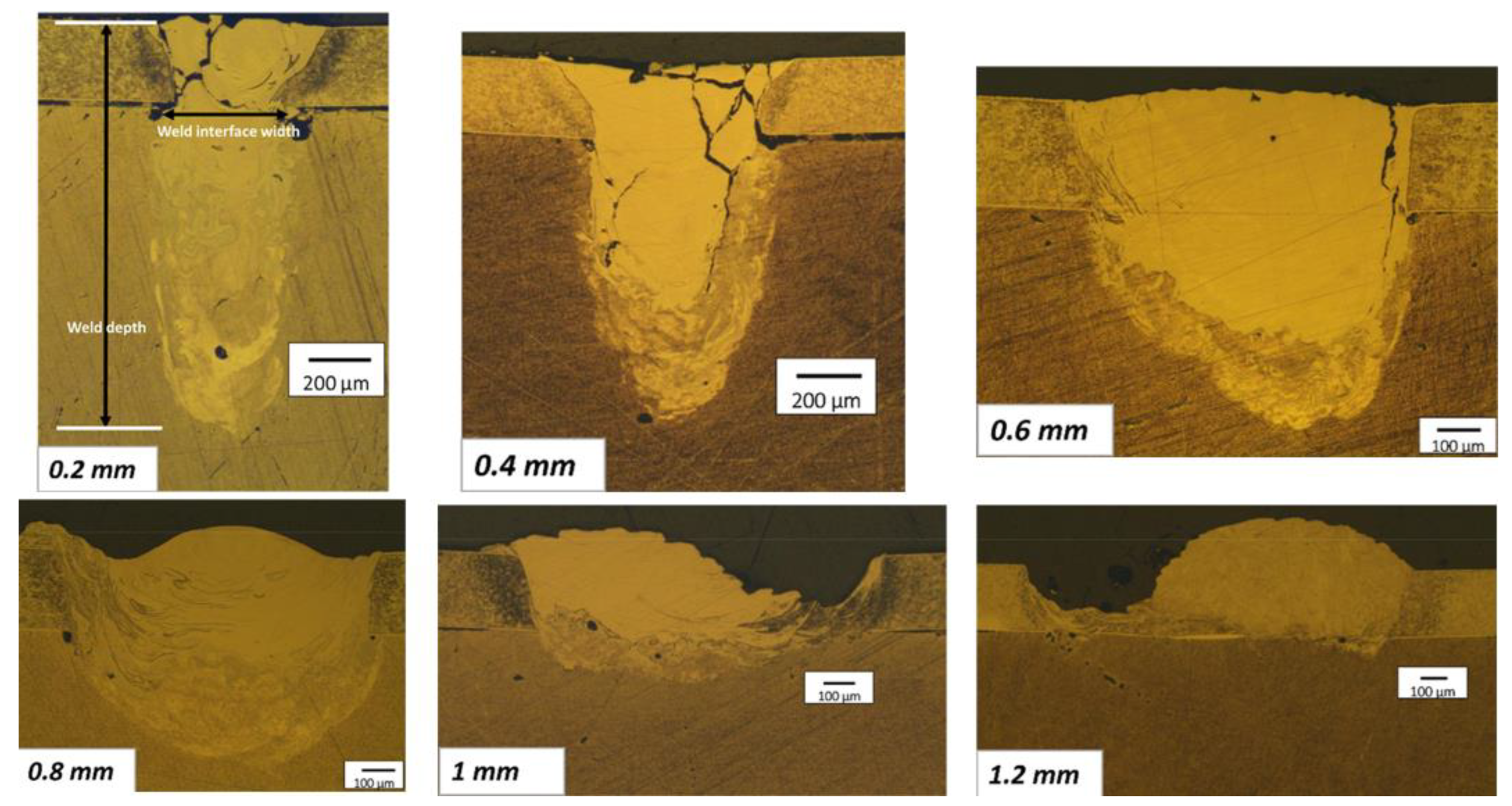
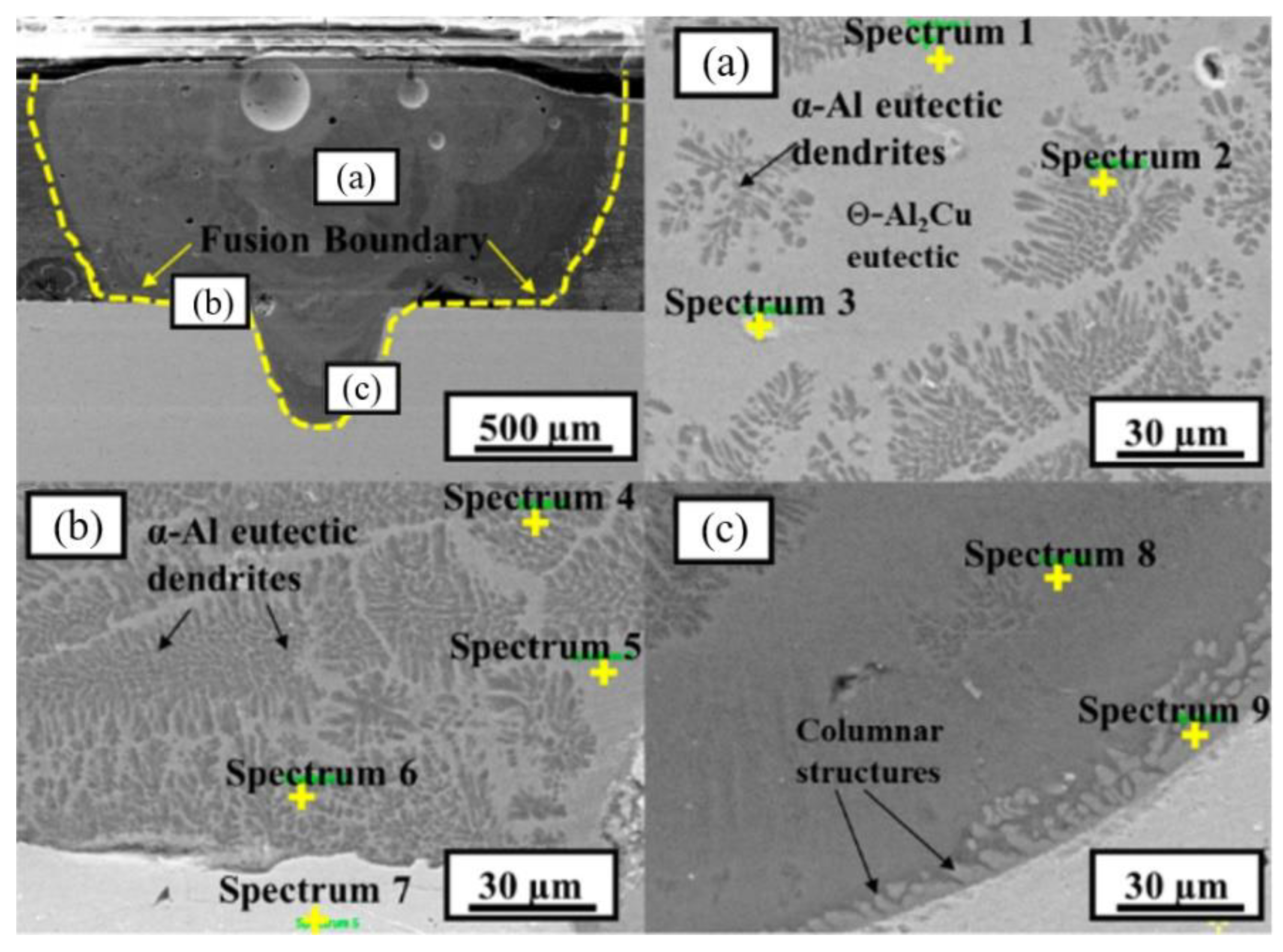
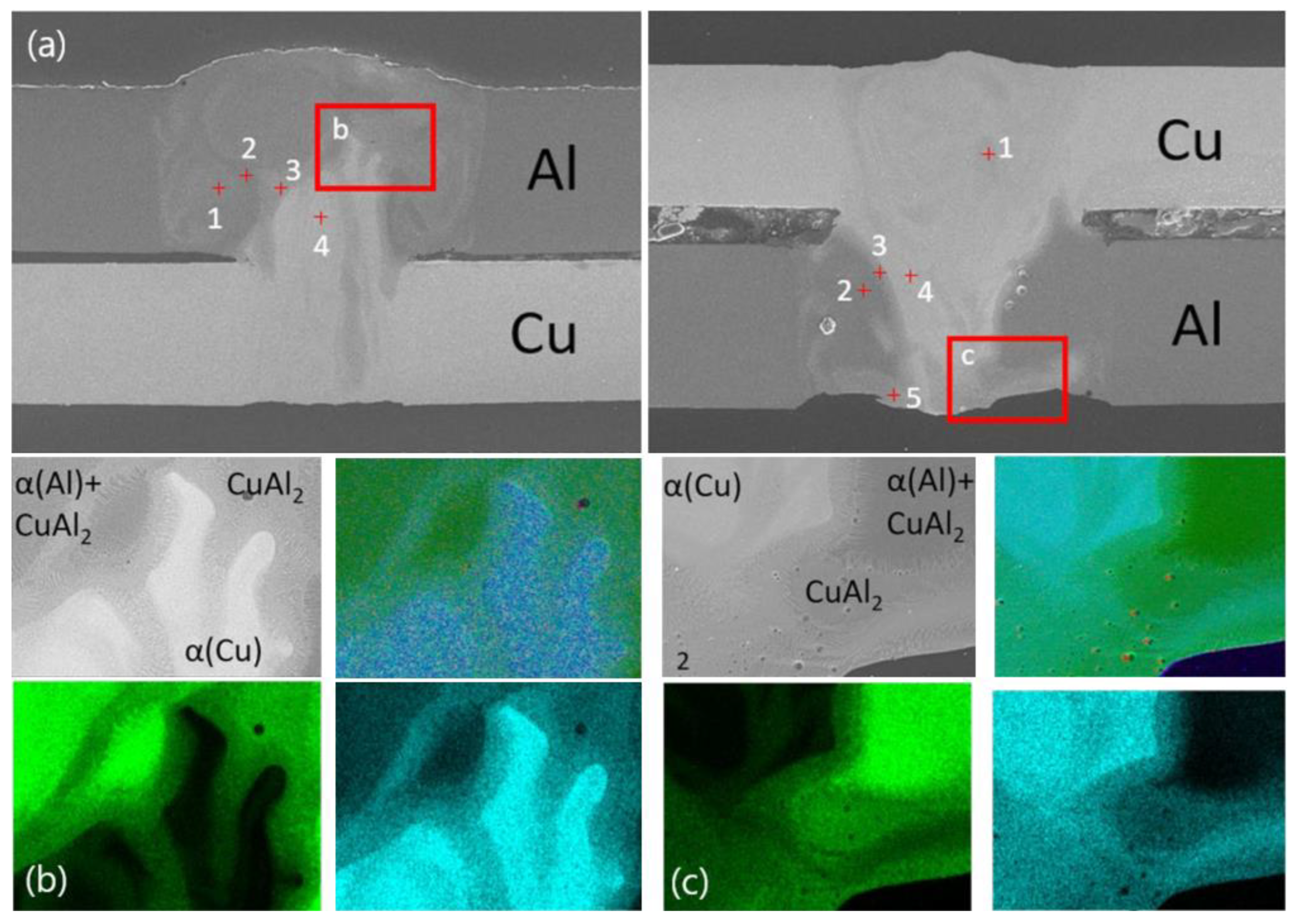
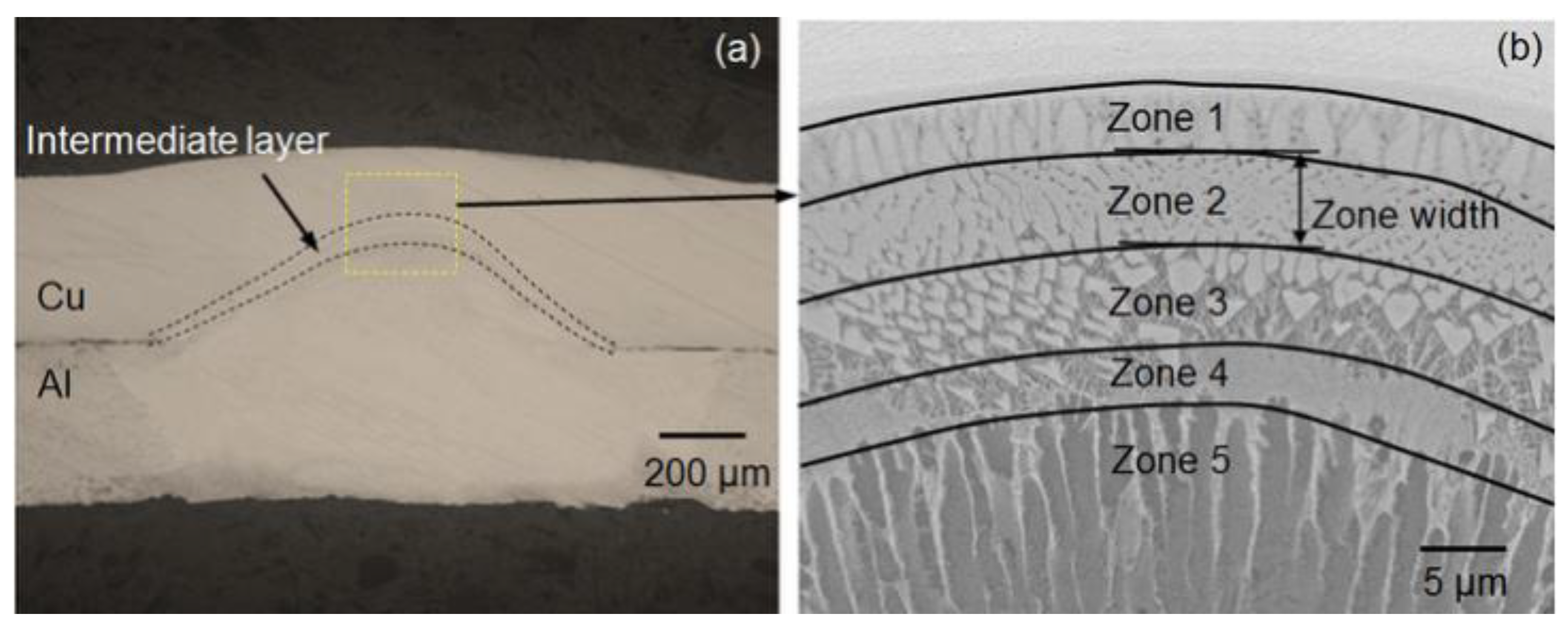
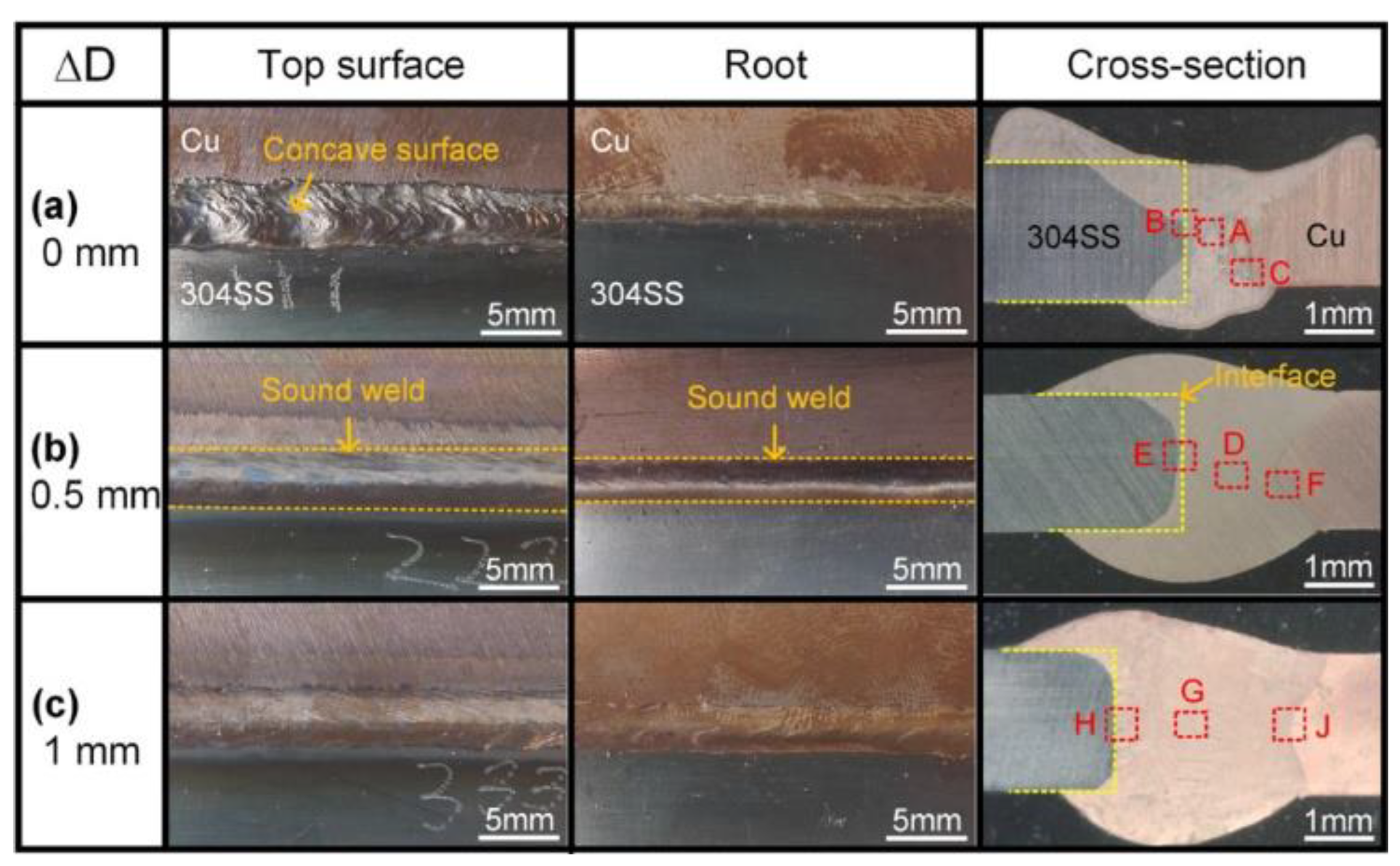
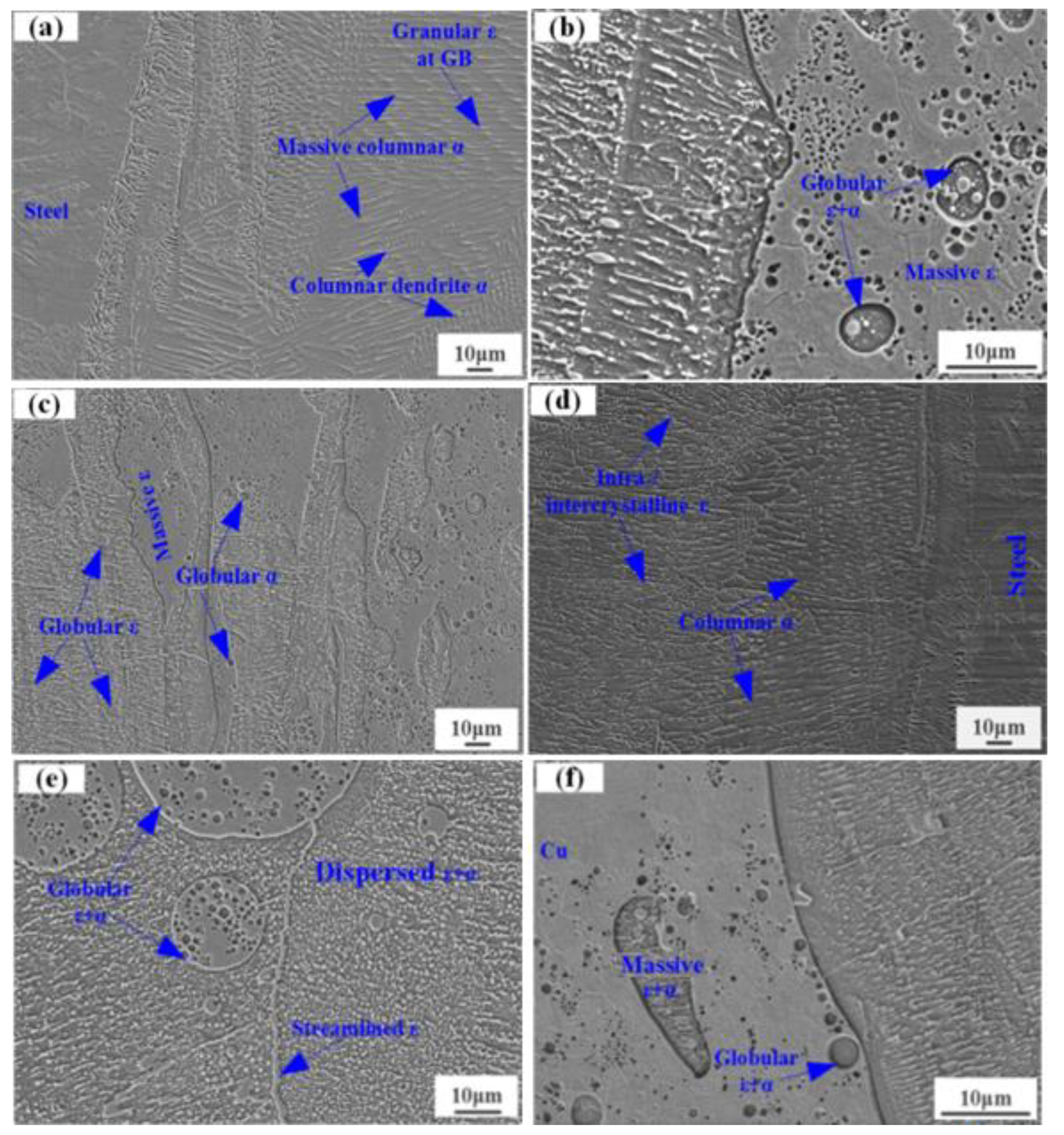
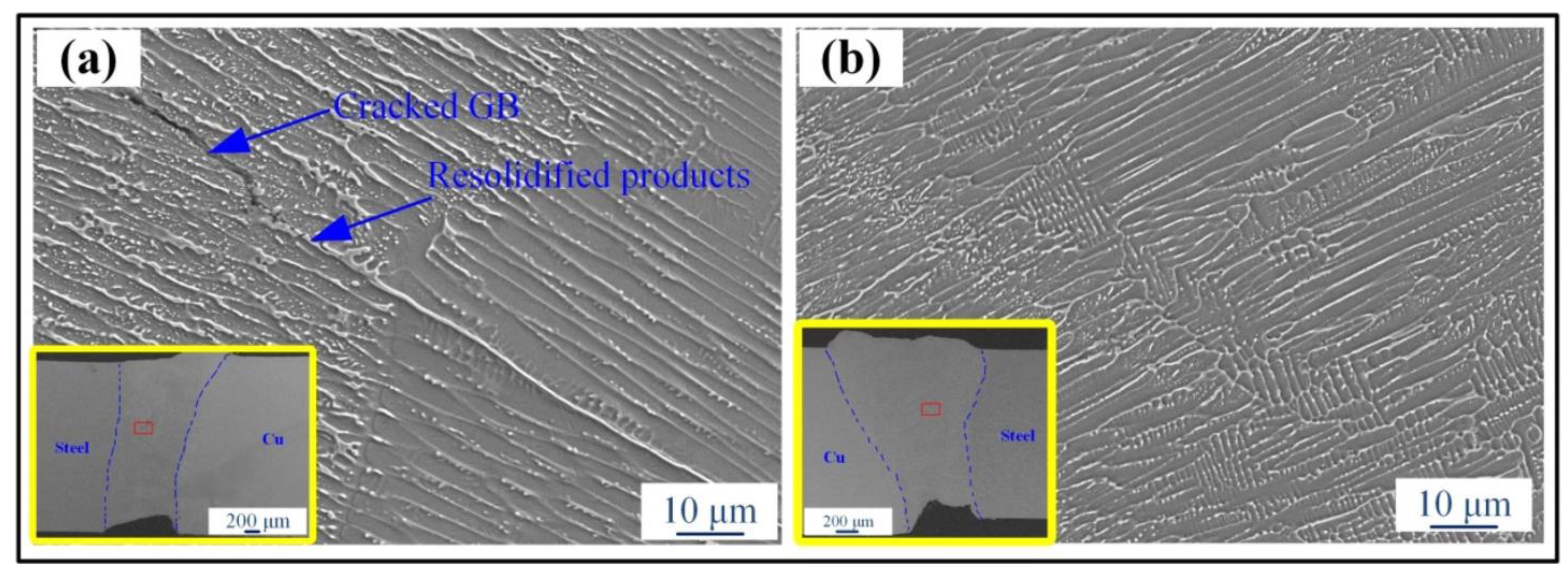
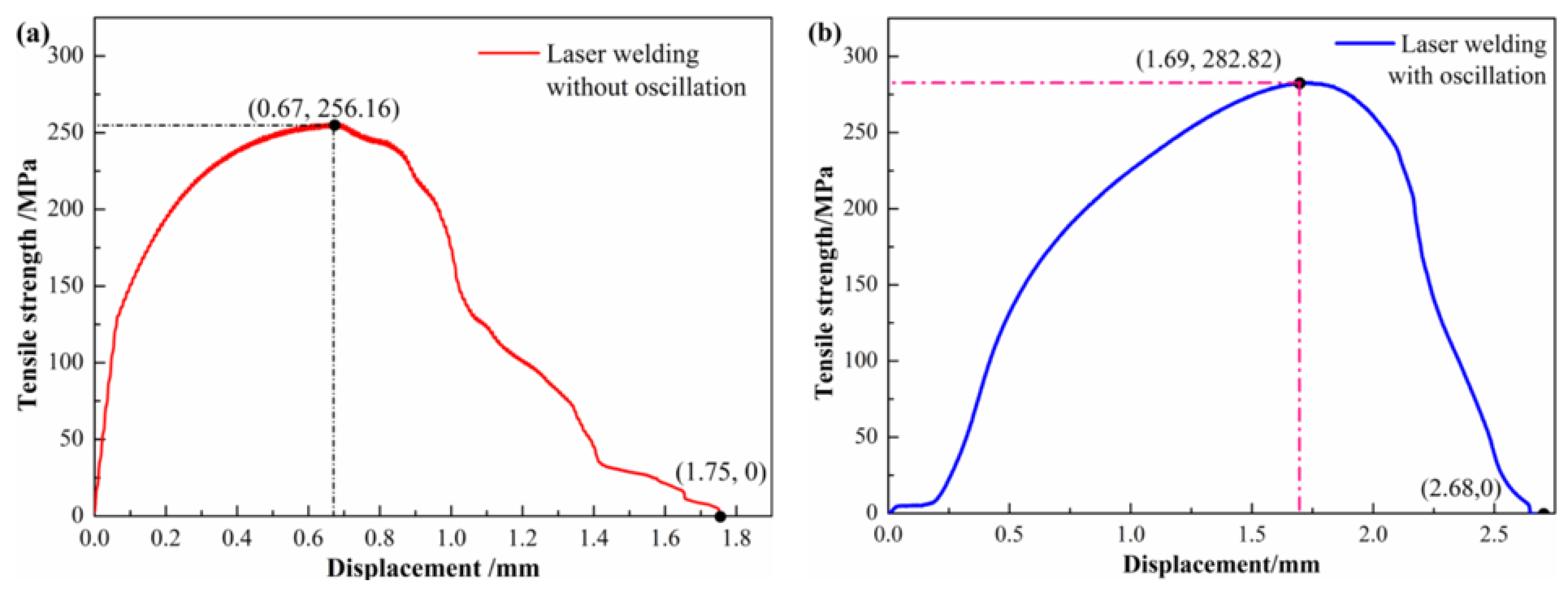
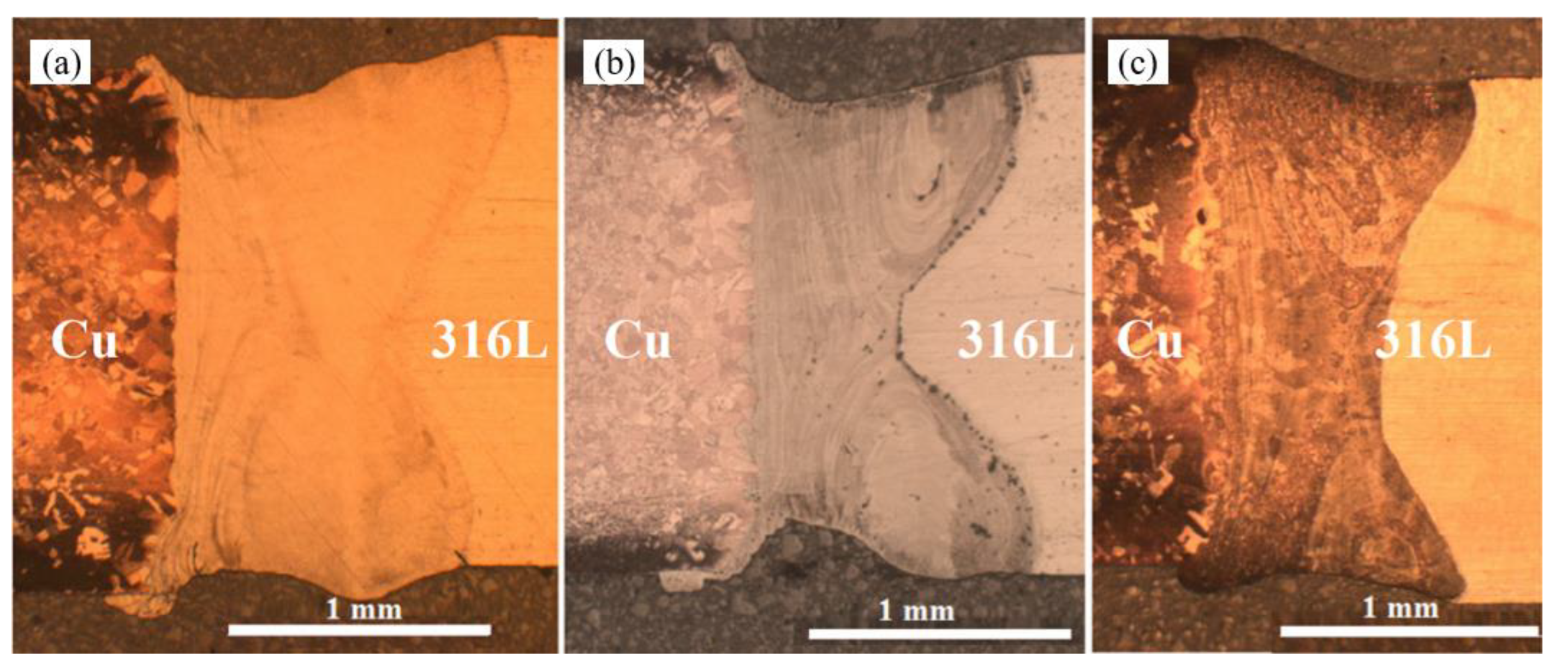

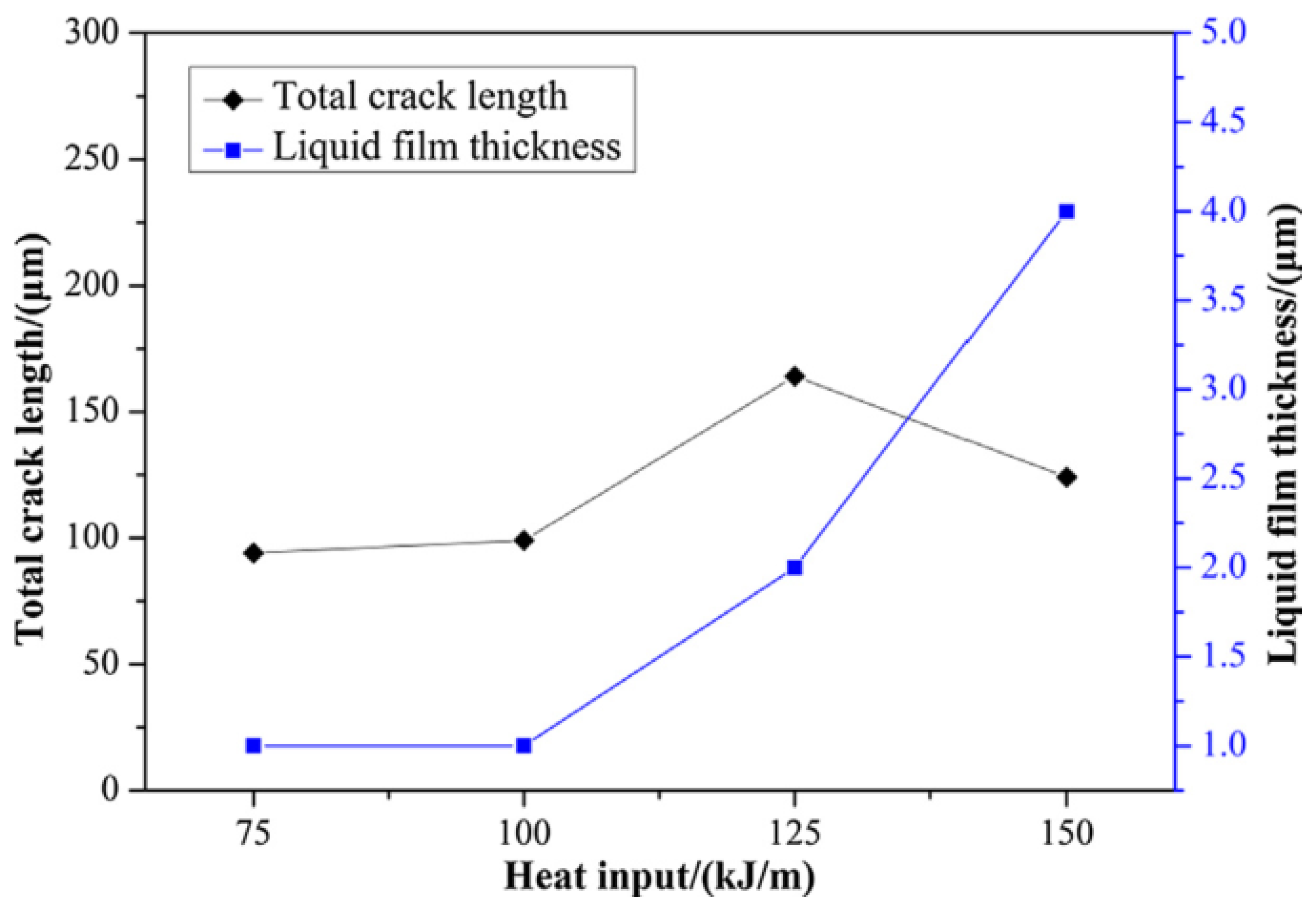
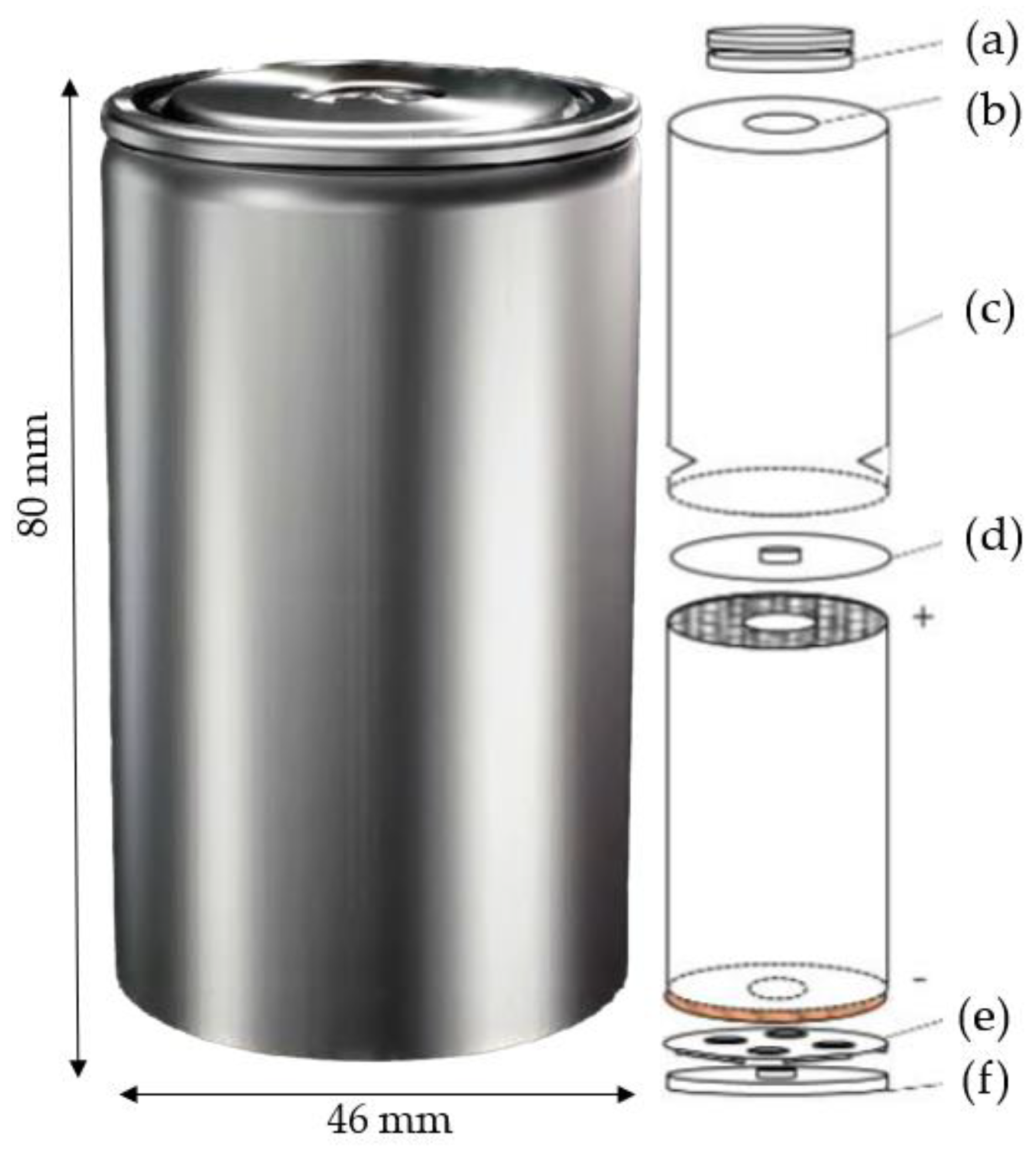

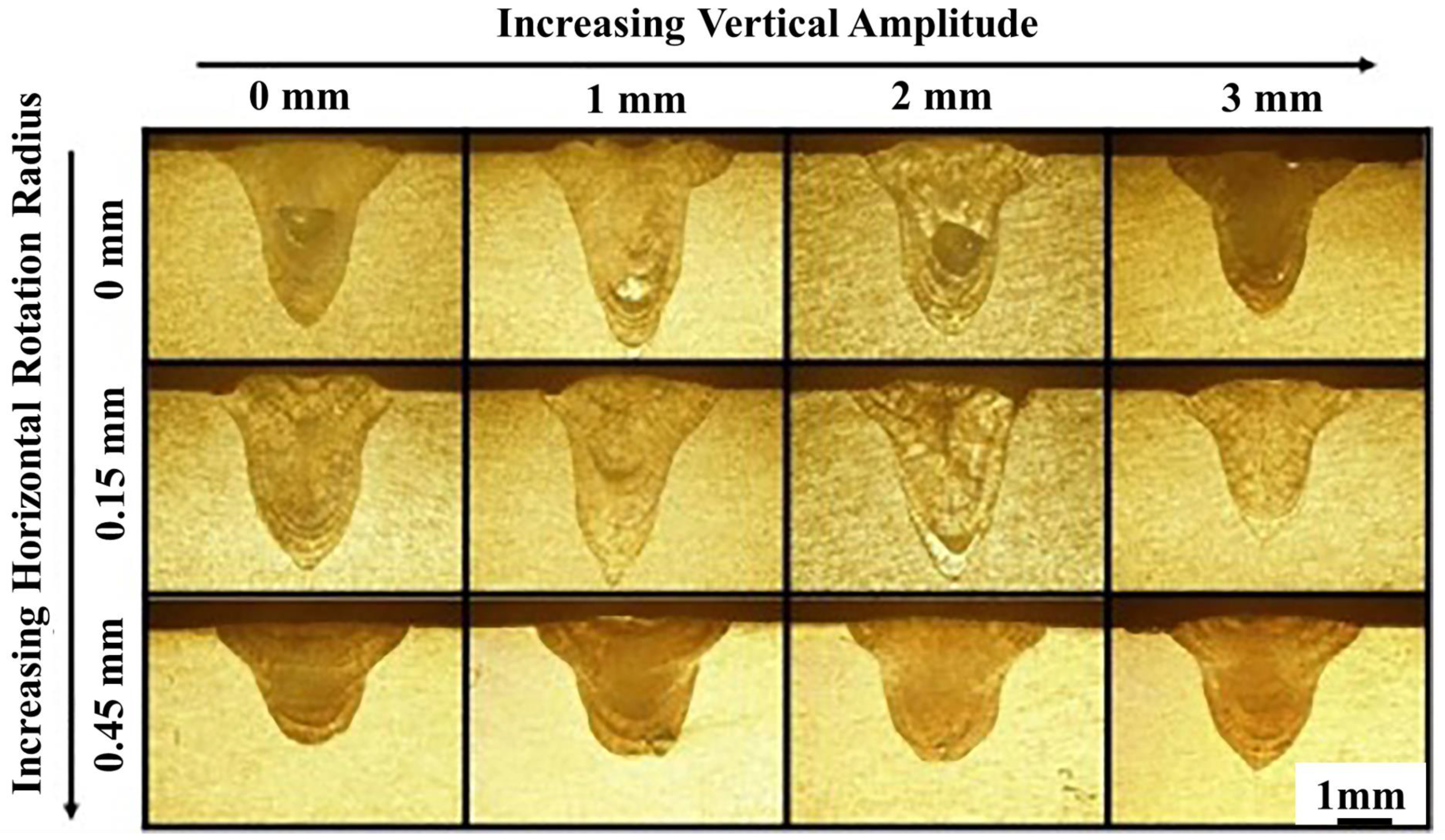
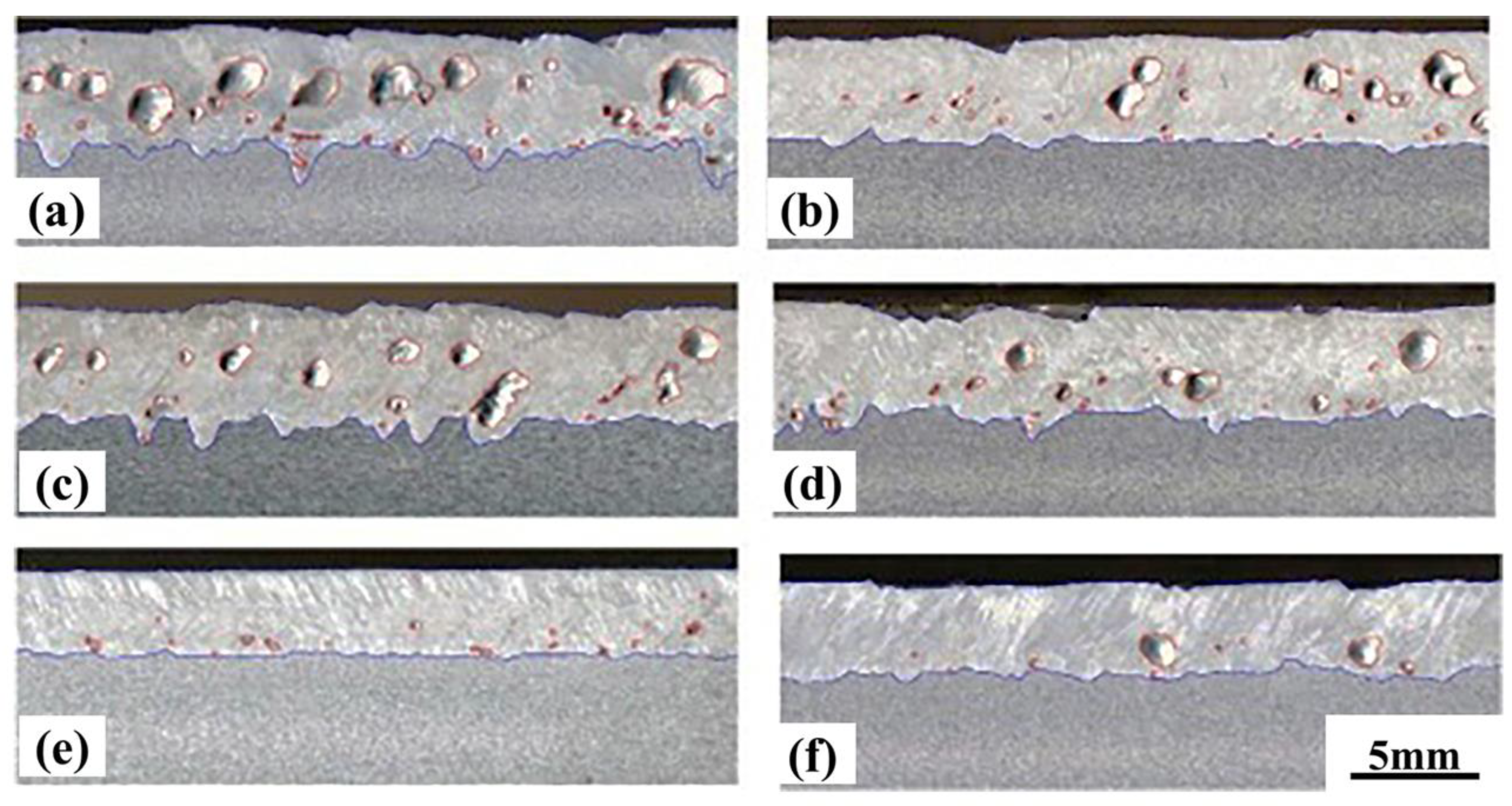
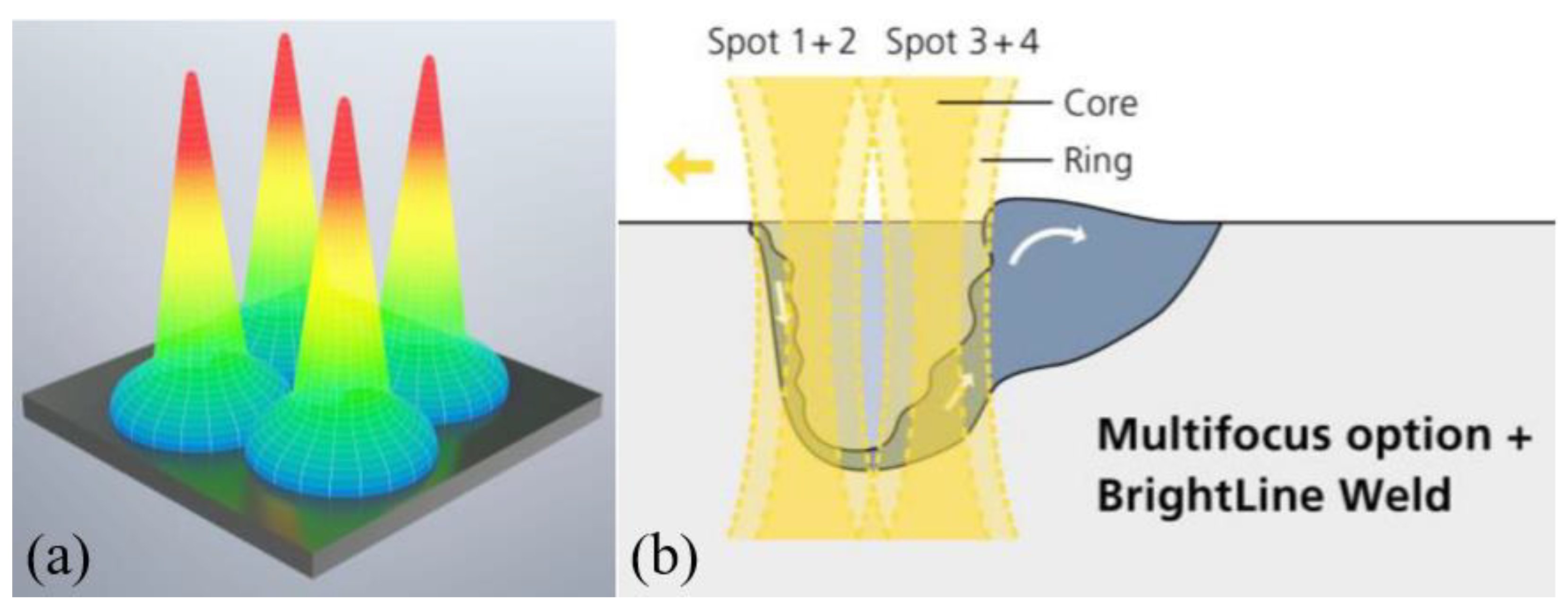
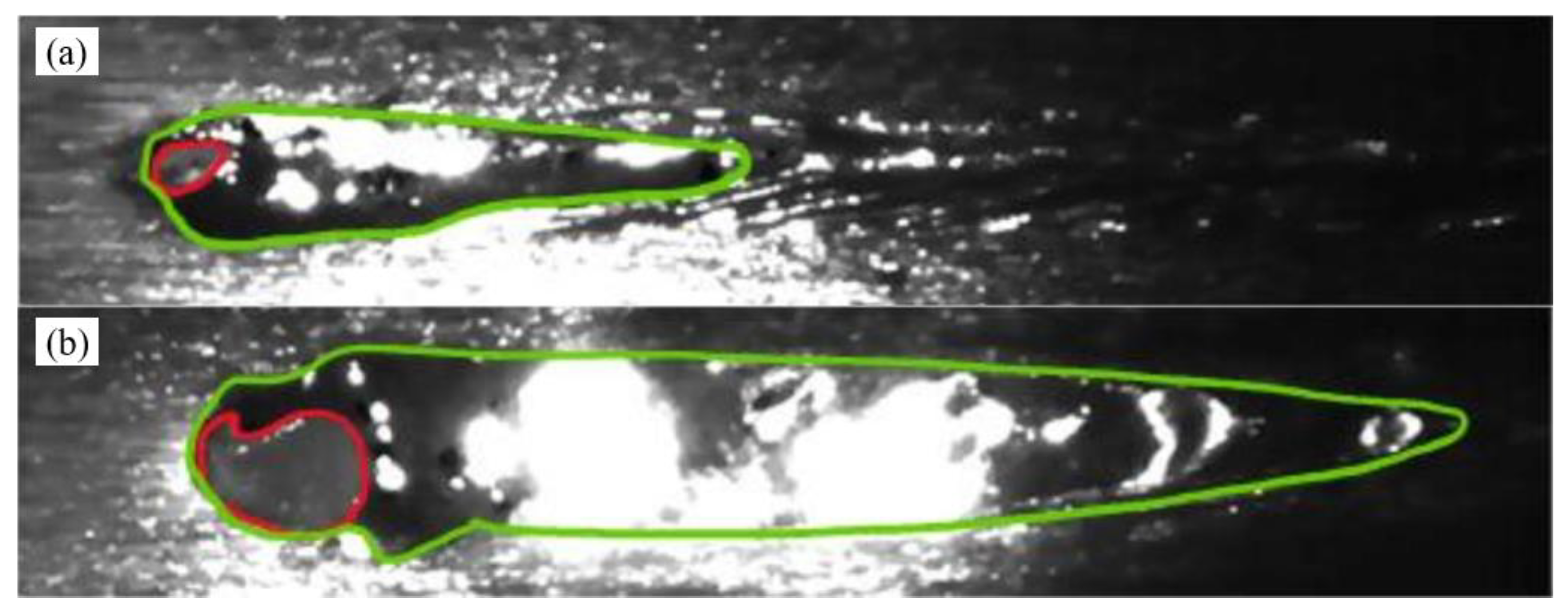

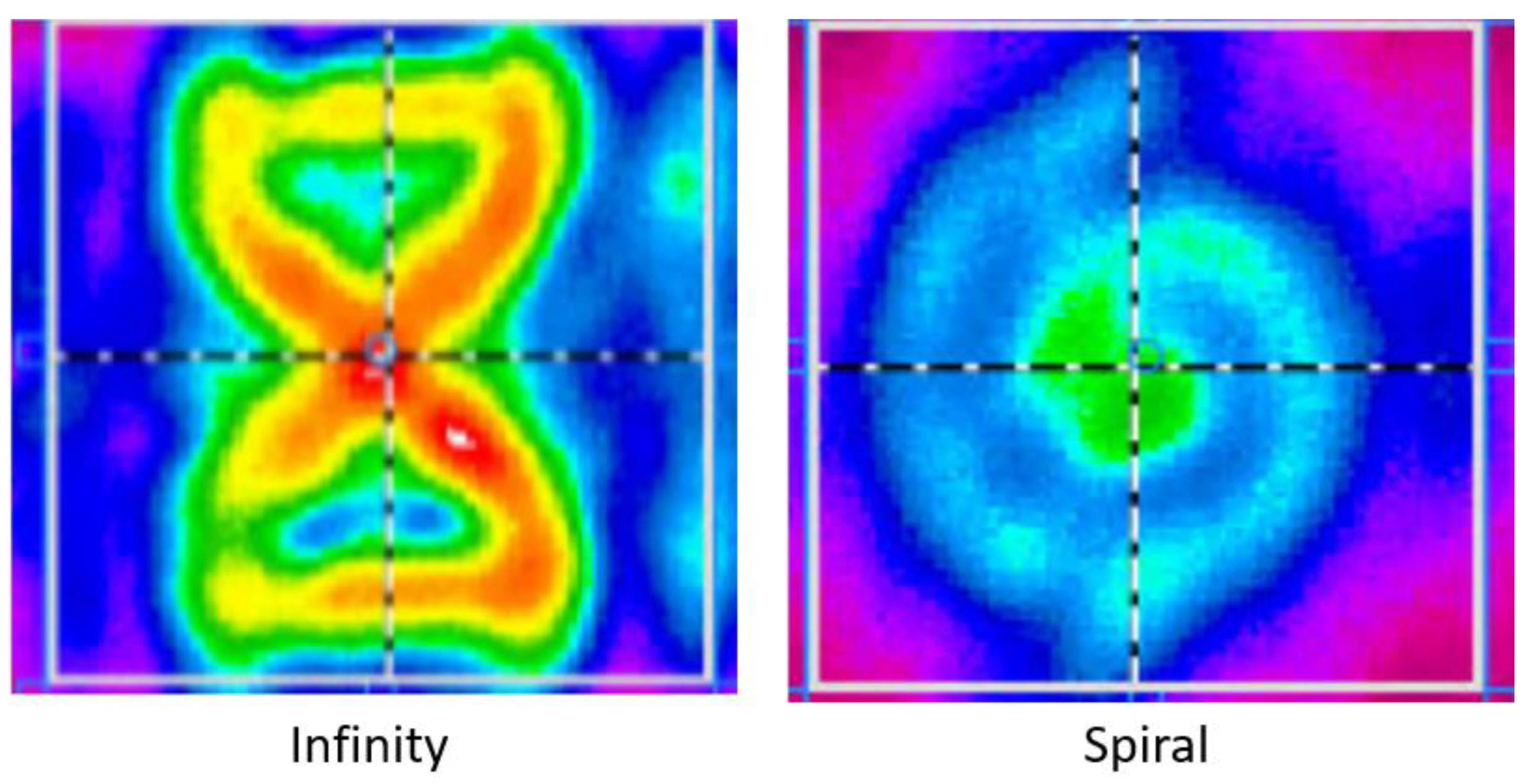
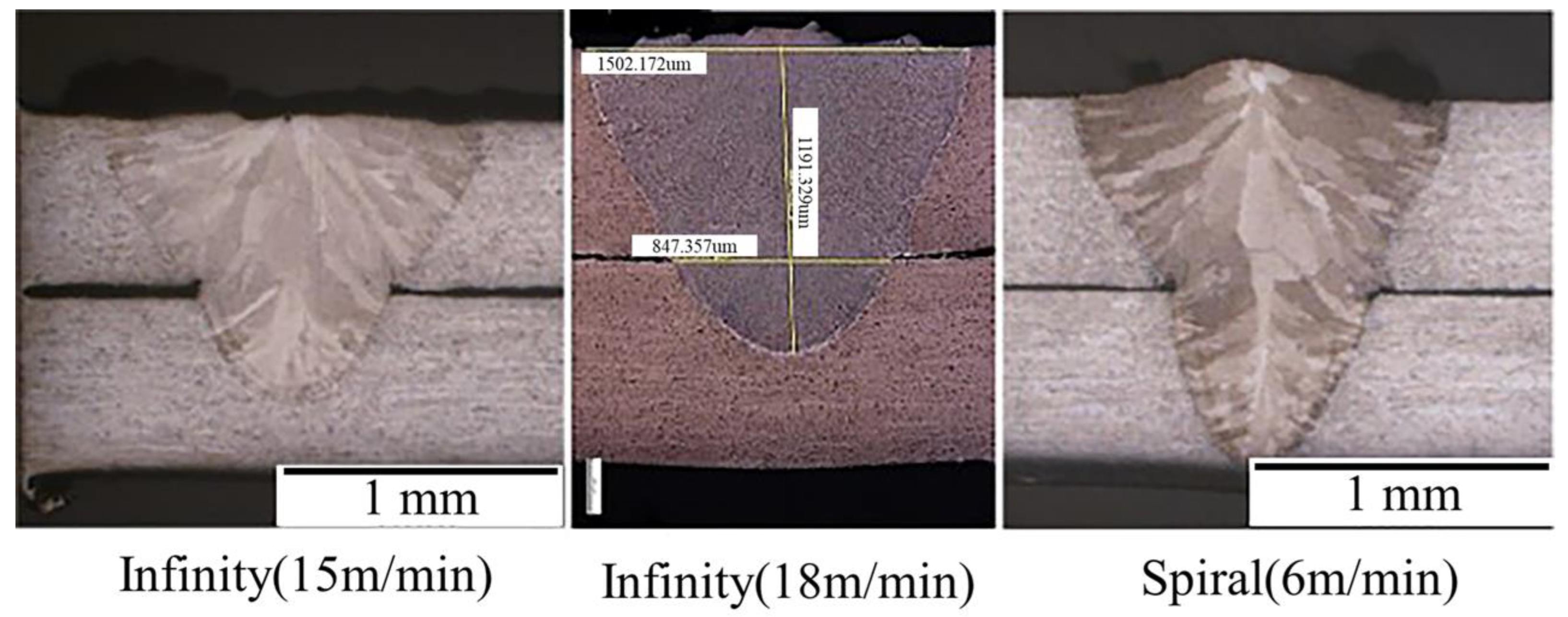


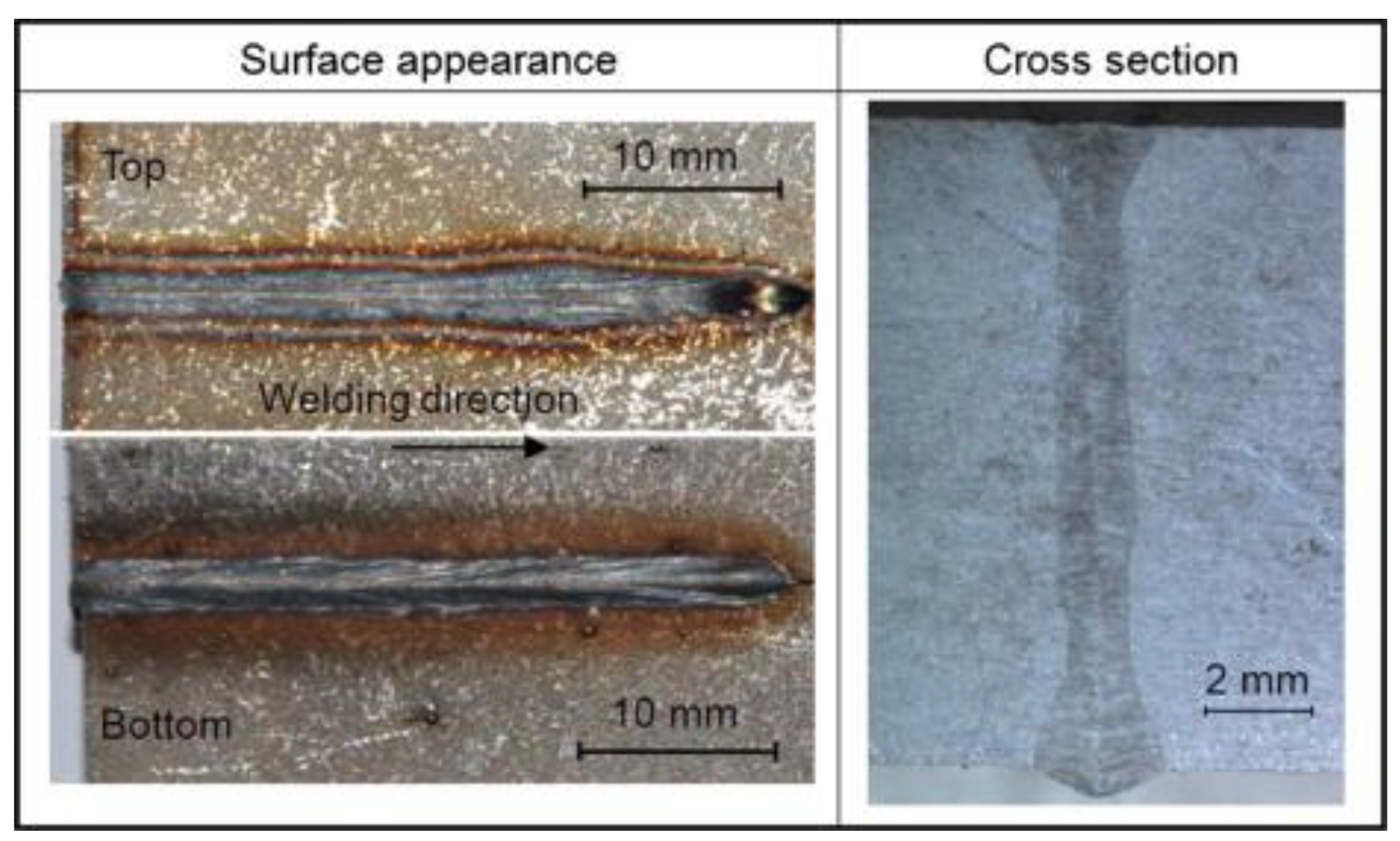

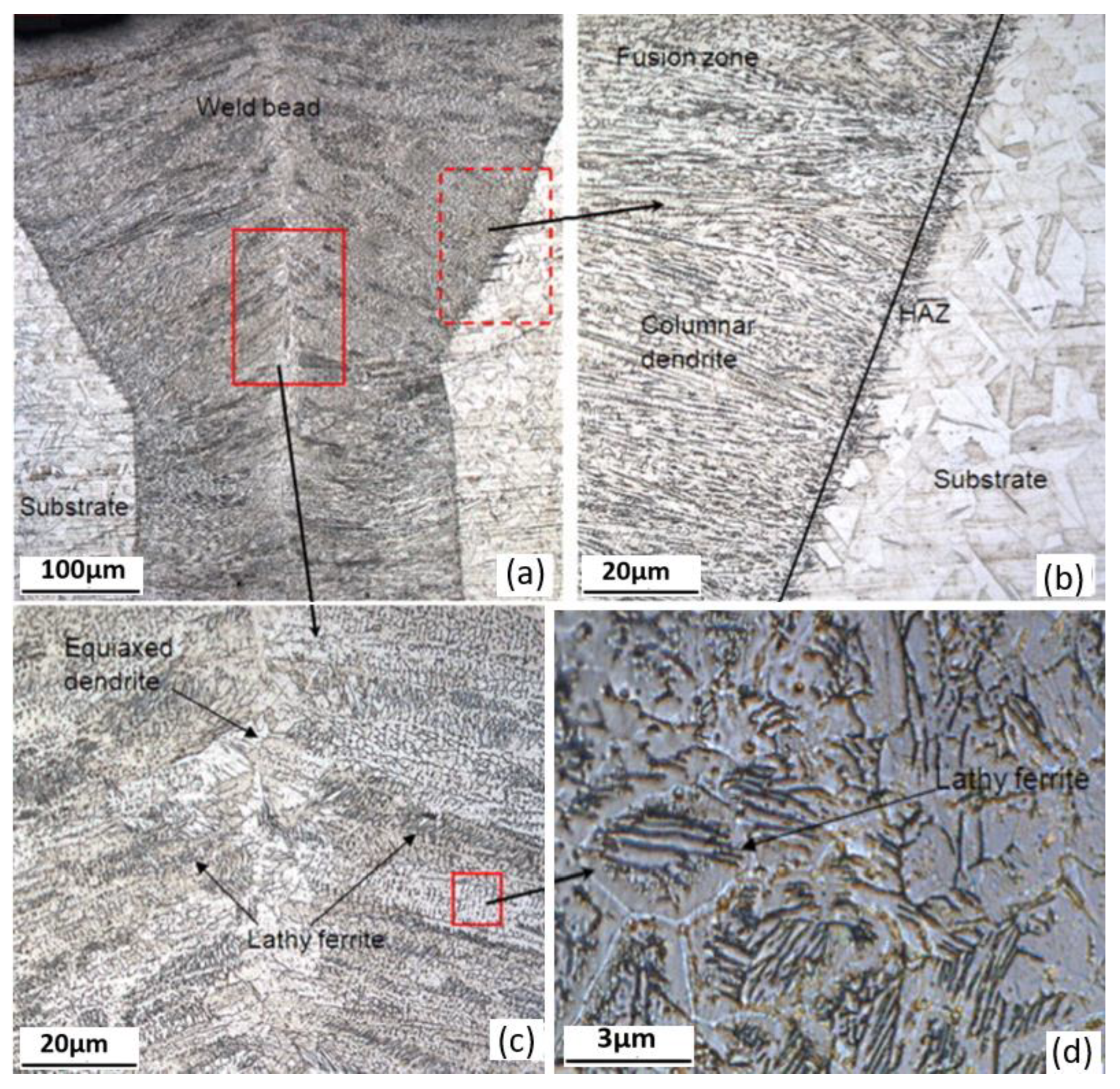
| Phases | Al at% | Hardness, HV | Crystal Structure | ΔG (KJ mol−1) |
|---|---|---|---|---|
| Fe2Al5 | 70–73 | 1000–1100 | orthorhombic | −19.64 |
| Fe4Al13/FeAl3 | 74.5–76.6 | 820–980 | BC monoclinic | −22.87 |
| FeAl2 | 66–66.9 | 1000–1050 | triclinic | −17.0 |
| FeAl | 23–55 | 400–520 | Simple cubic (B2 type) | −11.09 |
| Fe3Al | 23–34 | 250–350 | FCC | −4.83 |
| No. | Materials | Optimum Laser Parameters | Main Outcomes | Intermetallics | Ref. (year) |
|---|---|---|---|---|---|
| 1 | 1060 Al 316L stainless steel | Power: 285 W Speed: 4 mm·s−1 | The mechanical properties of the joint are related to the penetration depth | Not reported | [29] (2016) |
| 2 | 5754 Al 301 stainless steel | Power: 2 kW Speed: 1.4 m·min | Applying magnetic field can reduce grain size and stabilize weld quality | Fe2Al5 FeAl3 | [30] (2016) |
| 3 | Low carbon steel st14 5754 Al | Power: 200 W Peak power: 1.43 kWSpeed: 5 mm/s | Increasing pulse time, pulse peak power and overlapping factor will result in the formation of more intermetallic compounds in the weld | Fe2Al5 FeAl3 FeAl2 | [31] (2010) |
| 4 | 201 stainless steel 5052 Al | Not reported | The addition of nickel interlayer helps to improve the metallurgical reaction of aluminum and iron, forming Al0.9Ni1.1 to improve the mechanical properties of the weld | Fe2Al5 FeAl3 Al0.9Ni1.1 | [32] (2012) |
| 5 | Press-hardened steel 5052 Al | Power: 1.2 kW Speed: 12 mm/s | Using laser offset welding can improve the mechanical properties of weld | Fe2Al5 Fe4Al13 | [33] (2020) |
| 6 | 310S stainless steel 6061 Al | Power: 2.4 kW Speed: 1.5 m/min | Stainless steel surface helps to improve weld quality with laser cleaning before welding | Not reported | [34] (2021) |
| 7 | Hilumin steel 1050 Al | Power: 600 W Speed: 60 mm/s | With the increase in laser swing amplitude, the depth of weld decreases linearly, and the severity of weld cracking decreases significantly | Fe2Al5 Fe4Al13 FeAl2 | [35] (2022) |
| 8 | DC04 steel 6016-T4 Al | Power: 2 kW Speed: 1 m/min | The strength of the assemblies is shown to increase linearly with the reaction layer width | Not reported | [36] (2008) |
| 9 | H220YD 6061 Al | Power: 2600 W Speed: 1 m/min | By laser filling wire welding, the fused aluminum alloy and the filling wire can be brazed to galvanized solid steel | Al8Fe2Si Al13Fe4 Al2Fe | [37] (2013) |
| 10 | DP590 6061-T6 Al | Power: 2 kW Speed: 0.5 m/min | The joint produced with the AlSi5 filler metal had the highest tensile strength and largest fracture displacement. | Fe2Al5 FeAl3 Fe2Al8Si Fe(Al,Si)3 | [38] (2018) |
| Phase | Cu Content (at.%) | Structure | Microhardness (HV) | Density (g/cm3) | Specific Resistance (μΩ cm) |
|---|---|---|---|---|---|
| CuAl2 | 33 | Body-centered tetragonal | 630 | 4.34 | 8 |
| CuAl | 51 | Body-centered orthorhombic | 905 | 5.13 | 11.4 |
| Cu4Al3 | 55.5 | Monoclinic | 930 | NA | 12.2 |
| Cu9Al4 | 66 | Body-centered cubic | 770 | 6.43 | 14.2 |
| No. | Materials | Optimum Laser Parameters | Main Outcomes | Intermetallics | Ref. (Year) |
|---|---|---|---|---|---|
| 1 | Cu99.5% AA 1050 | Power: 1600 W Speed: 30 mm/s | The greater the heat input, the more intermetallic compounds are generated. The resistance decreases as the welding speed decreases. | Al4Cu9 Al2Cu | [49] (2022) |
| 2 | Cu99.9% Al99.9% | Power: 2000 W Speed: 400 mm/s | The fracture after welding is mainly on the copper side. | CuAl2 | [50] (2022) |
| 3 | Cu 110-H00 Al 3003-H14 | Power: 500 W Speed: 1 m/min | Adding tin alloy foil as interlayer can improve the mechanical properties of weld. | Not reported | [51] (2011) |
| 4 | T2 Cu 1060 Al | Power: 1450 W Speed: 100 mm/s | The microstructure of the subeutectic zone will greatly affect the shear resistance of the joint. | CuAl CuAl2 | [52] (2014) |
| 5 | Cu99.57% A1050 Al | Power: 1 Kw Speed: 10 m/min | Increasing the welding speed helps to reduce the content of intermetallic compounds in the weld. | CuAl CuAl2 | [40] (2013) |
| 6 | Oxygen-free Cu 4047 Al | Not reported | Controlling the melting ratio of metals is an important factor for defect-free welding of dissimilar metals. | Not reported | [48] (2004) |
| 7 | Pure Cu Pure Al | Not reported | The aluminum filler alloy AlSi12 produces a more uniform elemental mixture and a significantly enhanced ductility. | Not reported | [53] (2011) |
| Metal | Melting Temperature (K) | Boiling Temperature (K) | Density (Kg m−3) | Thermal Conductivity (W m−1 K−1) | Thermal Expansion Coefficient (106K−1) |
|---|---|---|---|---|---|
| Fe | 1809 | 3133 | 7870 | 78 | 12.1 |
| Al | 933 | 2739 | 2700 | 238 | 23.5 |
| Cu | 1356 | 2833 | 8930 | 398 | 17 |
| Ni | 1728 | 3188 | 8900 | 89 | 13.3 |
| No. | Materials | Optimum Laser Parameters | Main Outcomes | Intermetallics | Ref. (Year) |
|---|---|---|---|---|---|
| 1 | 304L stainless steel ETP Cu | Power: 1000 W Speed: 300 mm/min | A defect-free bimetallic joint between Cu and SS can be obtained by laser beam welding technique with fusion welding mode. | Not reported | [58] (2019) |
| 2 | 201 stainless steel T2 Cu | Not reported | Welding of copper/steel when welding—brazing and fusion welding depends on the welding parameters. | Not reported | [60] (2013) |
| 3 | 304 stainless steel T2 Cu | Power: 4 kW Speed: 3 m/min | Adding beam oscillation in laser welding can refine grain and enhance weld mechanical properties. | Not reported | [61] (2022) |
| 4 | 316L stainless steel CW Cu | Not reported | Excessive laser power can lead to the formation of thermal cracks. | Not reported | [62] (2018 |
| 5 | 304 stainless steel T2 Cu | Not reported | The susceptibility to HAZ liquation cracking can be effectively lowered by controlling the heat input during laser welding. | Cu40Fe60 CuxFe1-x | [63] (2020) |
| 6 | 316 stainless steel oxygen-free Cu | Not reported | By adjusting welding parameters, weld defects such as shrinkage, porosity, solidification cracks, etc., can be eliminated. | Not reported | [64] (2004) |
| 7 | Steel-Hilumin Cu | Power: 60 W Speed: 500 mm/min | Mechanical strength of the joint is highly correlated with electrical resistance and corresponding temperature rise at the joint. | Not reported | [15] (2019) |
Disclaimer/Publisher’s Note: The statements, opinions and data contained in all publications are solely those of the individual author(s) and contributor(s) and not of MDPI and/or the editor(s). MDPI and/or the editor(s) disclaim responsibility for any injury to people or property resulting from any ideas, methods, instructions or products referred to in the content. |
© 2023 by the authors. Licensee MDPI, Basel, Switzerland. This article is an open access article distributed under the terms and conditions of the Creative Commons Attribution (CC BY) license (https://creativecommons.org/licenses/by/4.0/).
Share and Cite
Feng, J.; Zhang, P.; Yan, H.; Shi, H.; Lu, Q.; Liu, Z.; Wu, D.; Sun, T.; Li, R.; Wang, Q. Application of Laser Welding in Electric Vehicle Battery Manufacturing: A Review. Coatings 2023, 13, 1313. https://doi.org/10.3390/coatings13081313
Feng J, Zhang P, Yan H, Shi H, Lu Q, Liu Z, Wu D, Sun T, Li R, Wang Q. Application of Laser Welding in Electric Vehicle Battery Manufacturing: A Review. Coatings. 2023; 13(8):1313. https://doi.org/10.3390/coatings13081313
Chicago/Turabian StyleFeng, Junbo, Peilei Zhang, Hua Yan, Haichuan Shi, Qinghua Lu, Zhenyu Liu, Di Wu, Tianzhu Sun, Ruifeng Li, and Qingzhao Wang. 2023. "Application of Laser Welding in Electric Vehicle Battery Manufacturing: A Review" Coatings 13, no. 8: 1313. https://doi.org/10.3390/coatings13081313
APA StyleFeng, J., Zhang, P., Yan, H., Shi, H., Lu, Q., Liu, Z., Wu, D., Sun, T., Li, R., & Wang, Q. (2023). Application of Laser Welding in Electric Vehicle Battery Manufacturing: A Review. Coatings, 13(8), 1313. https://doi.org/10.3390/coatings13081313








